When it comes to houseplants that effortlessly bring charm, character, and a touch of nature into our indoor spaces, Peperomia varieties stand out as shining stars.
With over 1,000 species belonging to this fascinating genus, Peperomias offer an astonishing array of shapes, colors, and textures that make them a favorite among plant enthusiasts.
In this comprehensive guide, we’ll explore 60 popular Peperomia varieties, discussing their unique features, care requirements, and why they’re perfect additions to your indoor garden.
Origins and Background:
Originating from tropical and subtropical regions across the globe, Peperomia plants have become popular choices for indoor gardening due to their adaptability and captivating appearances.
These plants hail from countries spanning from Central and South America to Africa and Asia, each species contributing to the impressive variety that we see today.
Read: Peperomia Benefits for Home and Health.
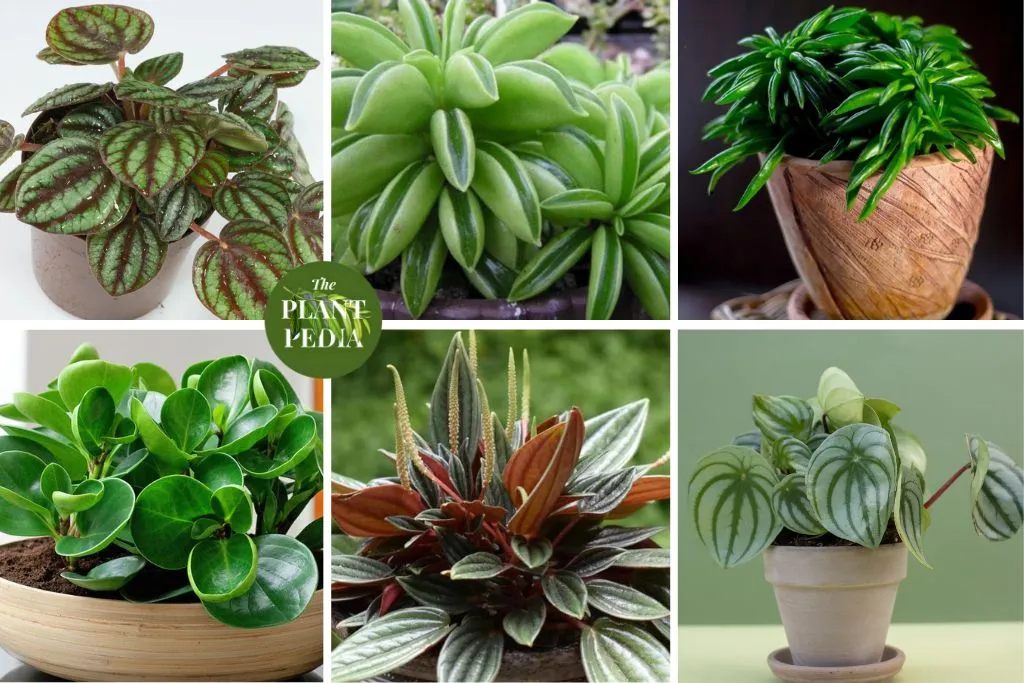
60 Peperomia Varieties For Indoor Gardens
There are over 1,000 species of Peperomia, but only a few hundred are commonly used as indoor plants. Here are 60 of the most popular types of Peperomia for indoor plants:
1. Argyreia
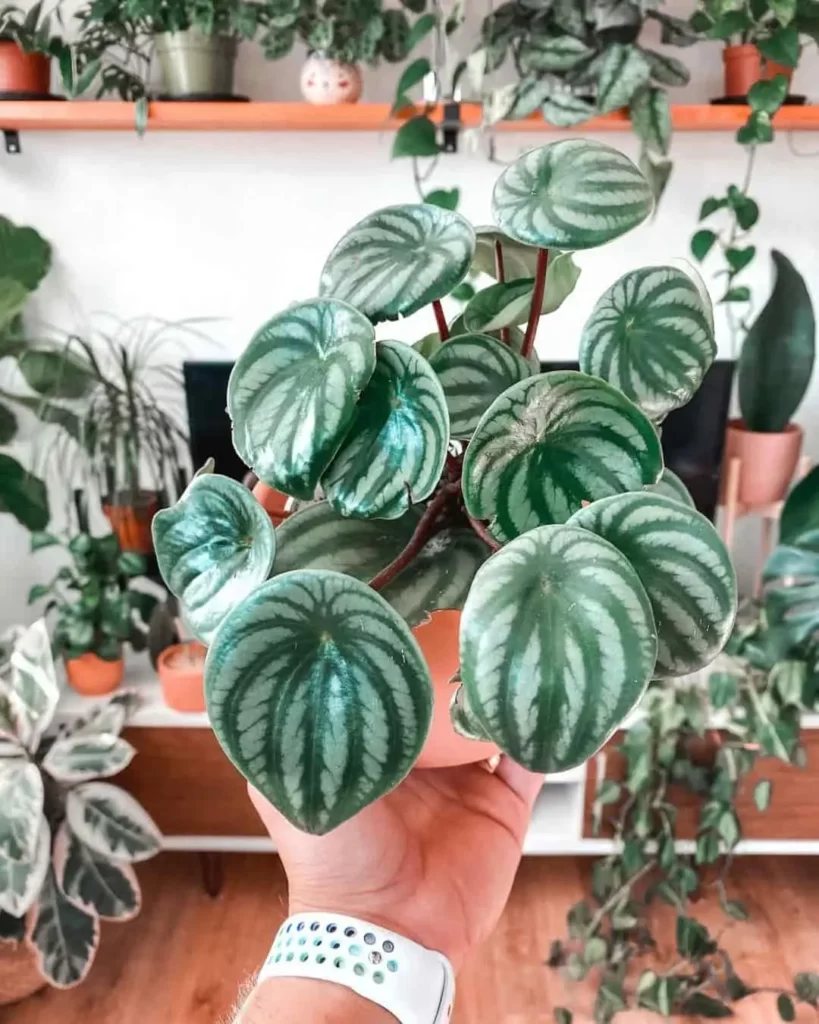
Peperomia argyreia, commonly known as the Watermelon Peperomia, is a charming and popular houseplant admired for its distinctive foliage reminiscent of a watermelon rind. Native to South America, particularly Brazil, this species belongs to the Piperaceae family, which also includes black pepper.
The Watermelon Peperomia is a compact, low-growing plant that typically reaches a height of 6 to 8 inches (15 to 20 centimeters) and spreads to about 8 to 12 inches (20 to 30 centimeters). Its succulent-like leaves are the main attraction, featuring an oval shape with a dark green hue, adorned with silver or grayish-green stripes and patterns that closely resemble the skin of a watermelon. This striking visual characteristic makes it a sought-after addition to any indoor plant collection.
Caring for Peperomia argyreia is relatively straightforward, making it an excellent choice for both beginners and experienced plant enthusiasts.
2. Asperula
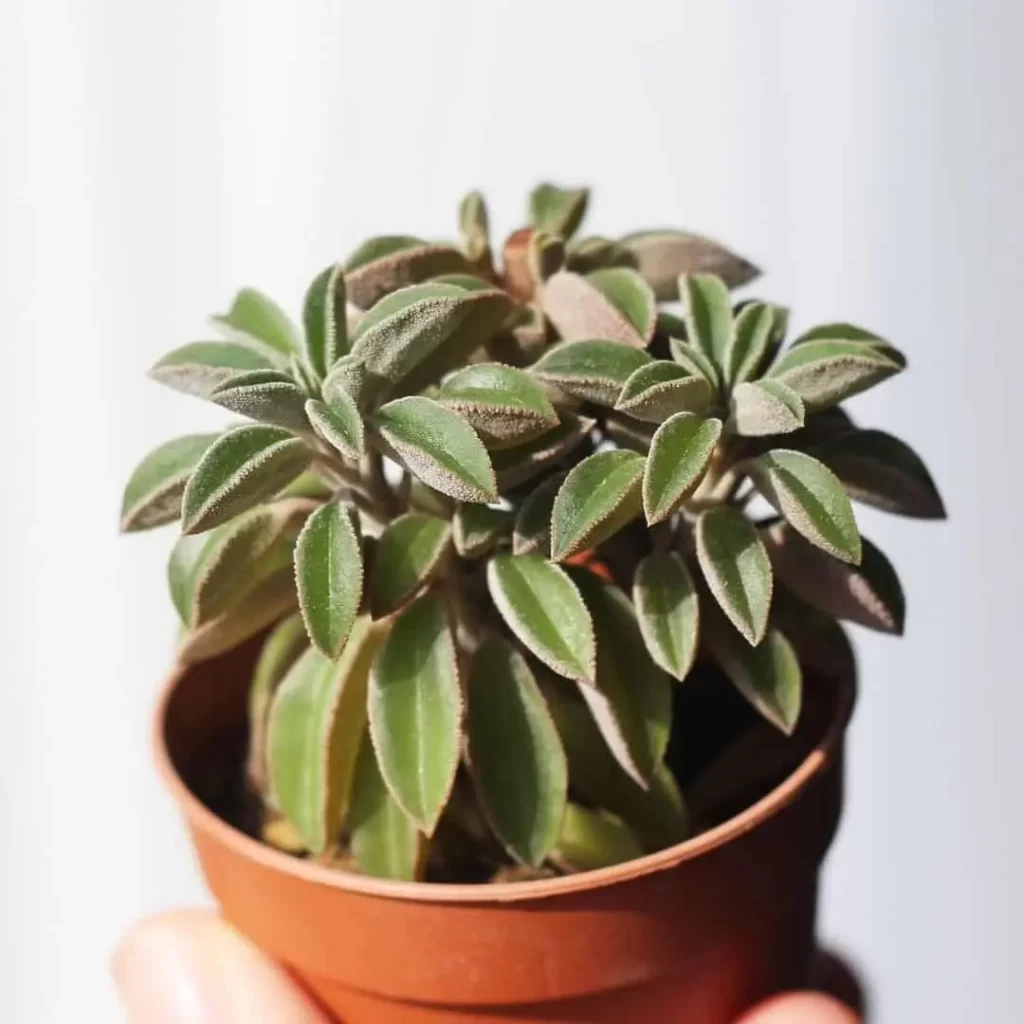
Peperomia asperula is a small, succulent plant native to the Andes Mountains of South America. It is known for its distinctive, taco-shaped leaves that are olive green with a grainy, tan underside. The plant can grow up to 12 inches tall and wide, and it produces small, white flowers in the spring and summer.
Peperomia asperula is a low-maintenance plant that is easy to care for. It prefers medium to bright indirect sunlight, but it can tolerate some direct sunlight in the morning or evening. The plant should be watered when the soil is dry to the touch, and it does not need to be fertilized very often. Peperomia asperula is tolerant of average humidity levels, but it will appreciate a bit of extra humidity if the air is dry.
3. Baby Rubber Plant
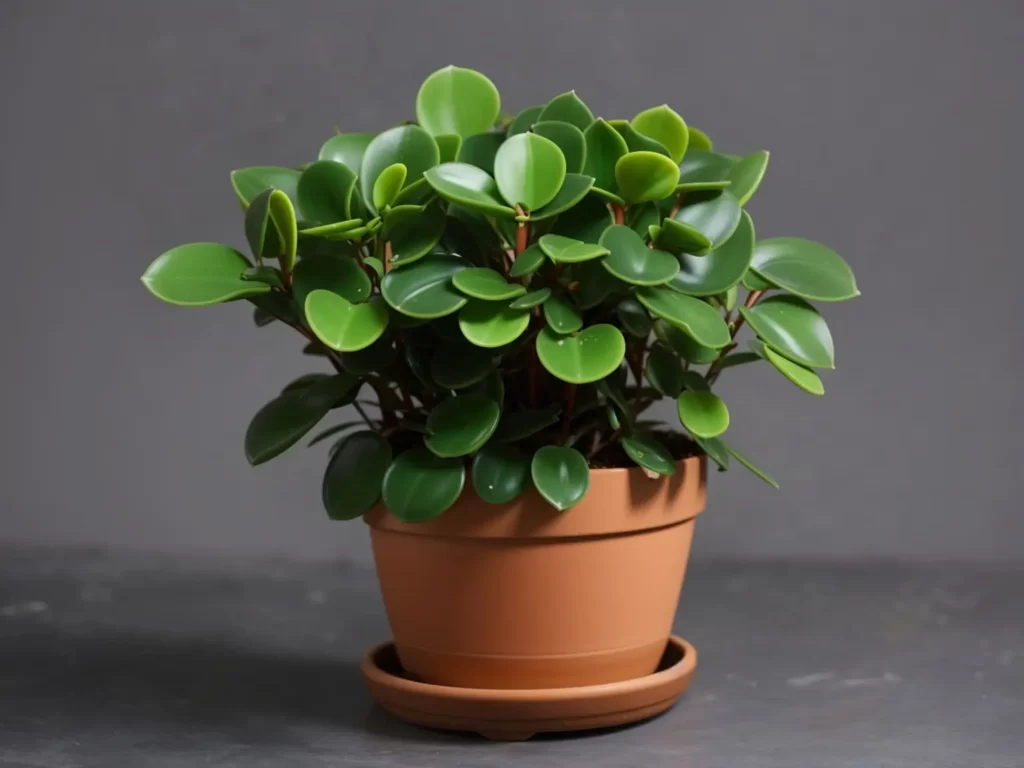
The Baby Rubber Plant, scientifically known as Peperomia obtusifolia, is a popular and delightful houseplant cherished for its compact size, glossy foliage, and easy-care nature. Native to regions of Central and South America, including parts of Florida, Mexico, and the Caribbean, this plant belongs to the Piperaceae family, which also includes black pepper.
Characterized by its succulent-like, fleshy leaves, the Baby Rubber Plant grows in a bushy, upright manner, typically reaching a height of 6 to 12 inches (15 to 30 centimeters). The leaves are dark green and have a waxy, rubbery texture, giving rise to its common name. They are often rounded or oval-shaped, with a smooth, blunt tip.
4. Bamboo Stalks
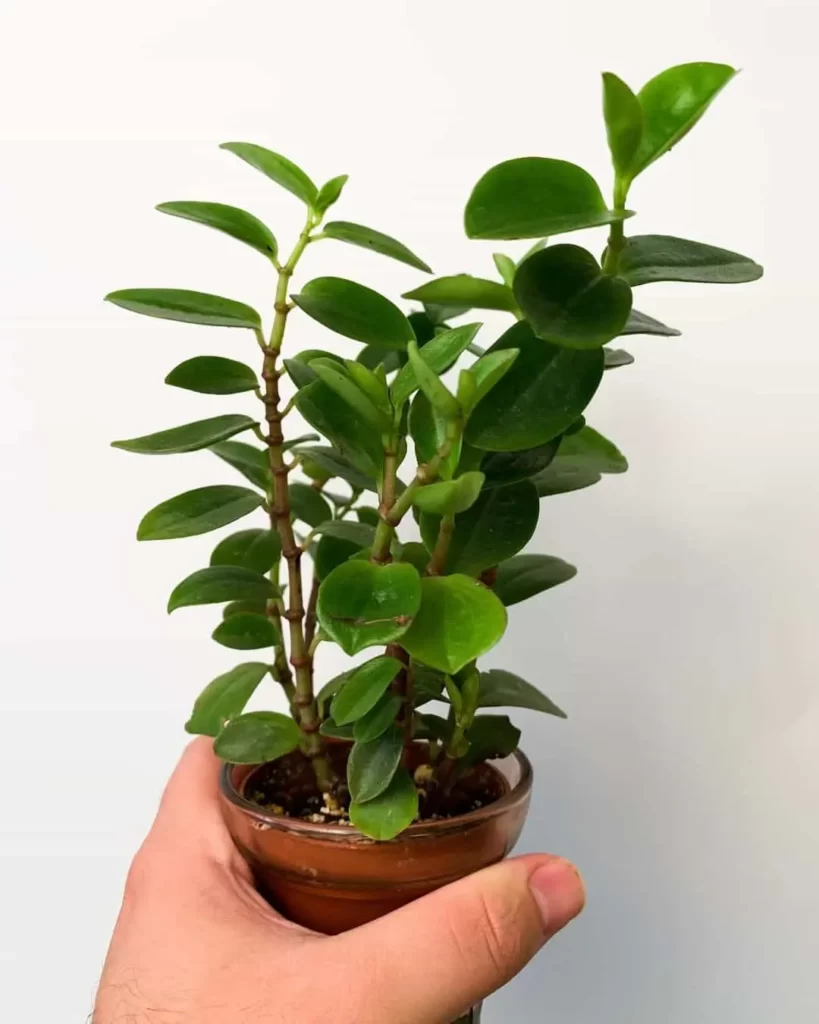
Peperomia Bamboo Stalks are perennial plants known for their striking upright growth habit, which closely resembles bamboo stalks. Unlike traditional bamboo, these plants belong to the Peperomia family and are prized for their lush foliage and intriguing form. They can reach an impressive height of up to 8 feet, adding a touch of vertical elegance to indoor or shaded outdoor spaces.
- Plant Type: Perennials
- Plant Size: Up to 8 feet
General Care Guidelines:
- Watering: These plants have relatively low water needs. It’s recommended to employ a bottom watering technique, allowing the top 2-4 inches of soil to dry out before providing moisture. This helps prevent overwatering and ensures healthy root development.
- Sun Exposure: Peperomia Bamboo Stalks thrive in environments with part shade. While they appreciate bright, indirect light, it’s important to shield them from direct sunlight. Too much sun exposure can lead to leaf burn or damage.
- Growth Pattern: Due to their upward growth habit, Peperomia Bamboo Stalks are not suitable for hanging pots. They flourish best when planted in containers or directly in the ground, allowing them to grow tall and graceful.
Special Considerations:
- Rare Variety: Peperomia Bamboo Stalks are considered rare in the world of houseplants, making them a coveted find for collectors and enthusiasts.
Additional Tips:
- Provide a well-draining potting mix to prevent waterlogging and promote healthy root development.
- Maintain a slightly more humid environment to support optimal growth.
- Regularly inspect for pests like spider mites, mealybugs, and aphids, and address any infestations promptly.
Caring for Peperomia Bamboo Stalks can be a rewarding experience for plant lovers looking to add a touch of uniqueness to their indoor or shaded outdoor spaces. With the right conditions and attention, these plants can thrive and become a captivating focal point in your botanical collection.
5. Bangroana
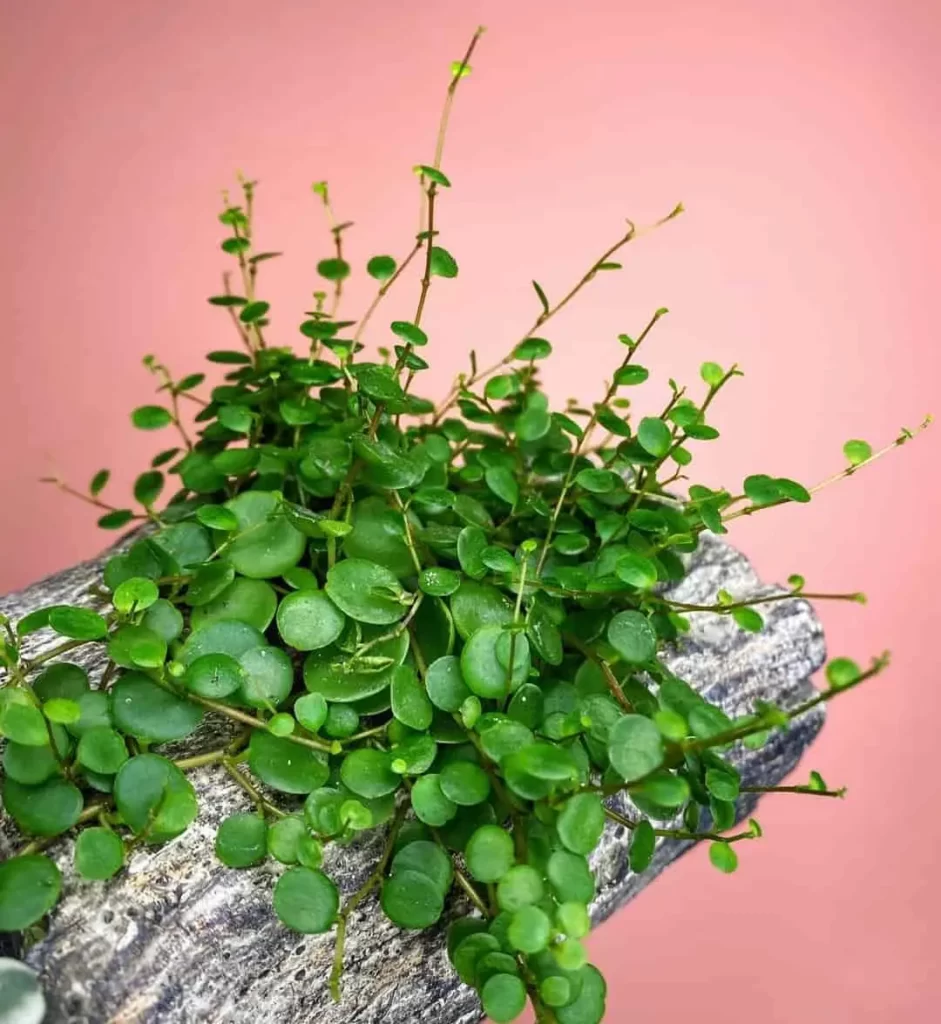
Peperomia Bangroana, also known as the “Bangroana Peperomia,” is an intriguing and unique houseplant that hails from the tropical regions of Central and South America. It belongs to the Peperomia genus, which is known for its diverse and visually captivating foliage. Unlike its more commonly found cousin, the Baby Rubber Plant (Peperomia obtusifolia), the Bangroana variety has distinct characteristics that set it apart.
This particular Peperomia variety is known for its striking variegated leaves. Each leaf displays a mesmerizing pattern of light and dark green hues, creating a visually arresting effect. The leaves are generally small, thick, and have a slightly succulent texture, which is a common trait in many Peperomia species. The plant typically grows in a compact, bushy manner, reaching a height of around 8 to 12 inches (20 to 30 centimeters).
6. Beetle

Peperomia Beetle, scientifically known as Peperomia quadrangularis, is a charming and unique member of the Peperomia genus. Native to the tropical regions of Central and South America, this distinctive houseplant is prized for its striking appearance and ease of care. It earned its common name, “Beetle Peperomia,” due to the fascinating resemblance of its leaves to the shape and markings of a beetle.
One of the standout features of the Peperomia Beetle is its leaf structure. The leaves are thick and succulent, with a square or rectangular shape, resembling the form of a beetle’s body. The deep green leaves are adorned with intricate silver or cream-colored stripes and patterns that resemble the intricate designs often seen on the shells of beetles. These patterns create a visually captivating and mesmerizing effect, making the Peperomia Beetle a popular choice among plant enthusiasts and collectors.
In terms of size, this variety of Peperomia typically grows in a compact and bushy manner, reaching a height of around 6 to 8 inches (15 to 20 centimeters). Its relatively petite stature makes it ideal for small spaces, shelves, or as part of a plant arrangement.
Caring for the Peperomia Beetle is relatively straightforward, making it suitable for both beginners and experienced plant enthusiasts.
7. Belly Button
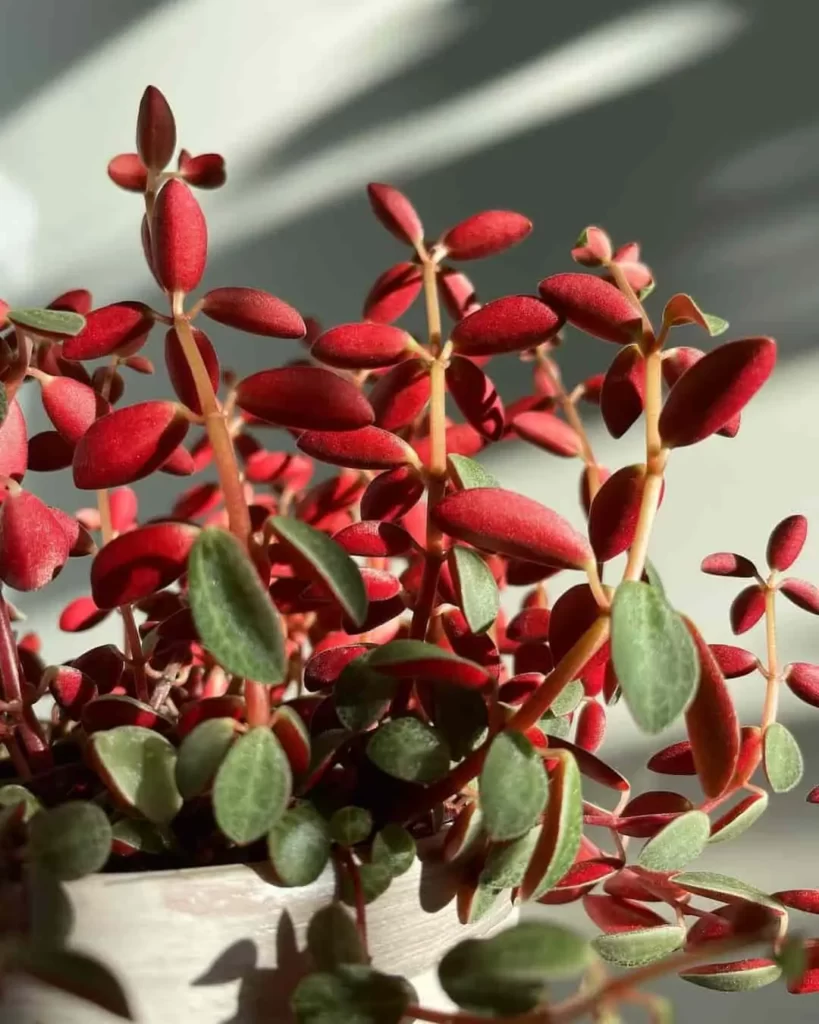
Peperomia Belly Button, scientifically known as Peperomia verticillata, is a charming and popular houseplant known for its distinctive foliage and compact size. Native to tropical and subtropical regions of Central and South America, this unique variety of Peperomia has gained popularity among plant enthusiasts for its adorable and intriguing appearance.
The name “Belly Button Peperomia” stems from the plant’s round, button-like leaves that closely resemble a belly button, particularly in its young growth stages. These leaves are glossy and fleshy, with a deep green coloration. As the plant matures, it forms a dense cluster of these intriguingly shaped leaves, creating a visually appealing and compact display.
8. Bibi
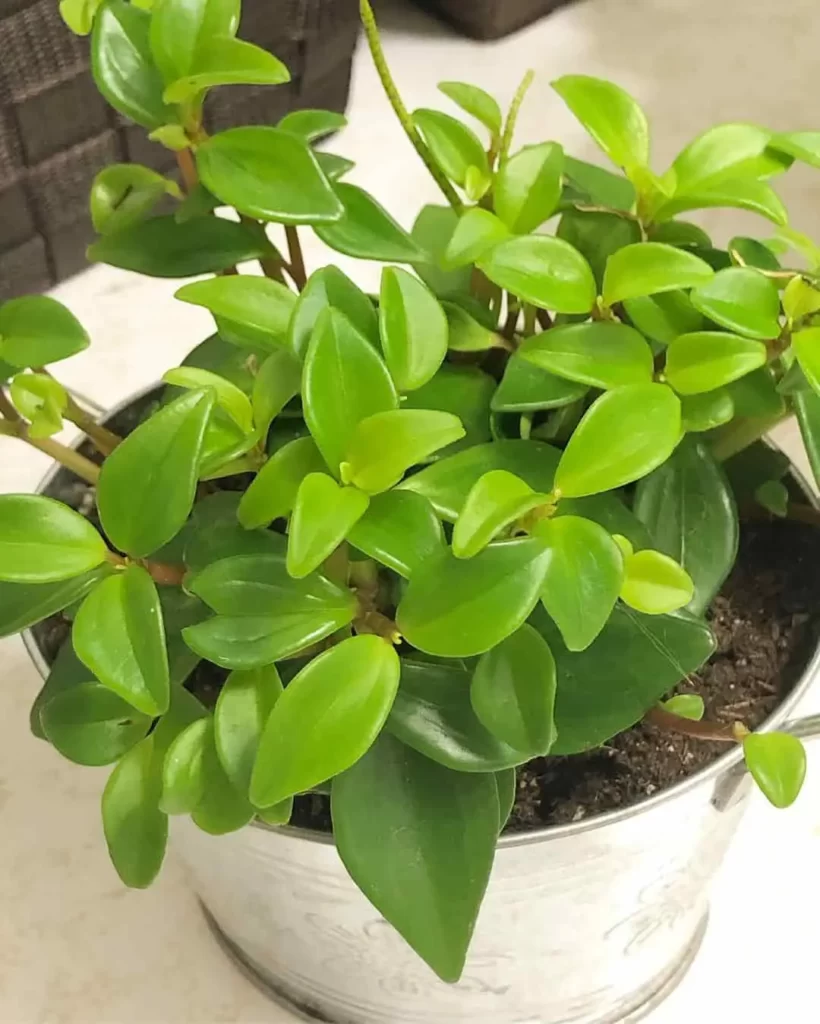
Peperomia trinervula, commonly referred to as Bibi Peperomia, is a captivating houseplant known for its delicate and distinctive foliage. Native to the tropical regions of Central and South America, this species belongs to the Peperomia genus, which is celebrated for its diverse and visually intriguing leaf patterns.
The Bibi Peperomia is characterized by its small, succulent-like leaves that are typically green with striking red or burgundy undersides. This feature lends the plant an enchanting visual contrast, making it a sought-after choice for indoor gardeners. The leaves are generally elliptical or heart-shaped and are arranged in an attractive whorled pattern along the stems.
This variety of Peperomia is relatively petite, typically growing to a height of about 4 to 8 inches (10 to 20 centimeters). Its compact size and visually appealing foliage make it an excellent choice for smaller spaces, hanging baskets, or as part of a plant arrangement.
9. Brazilian
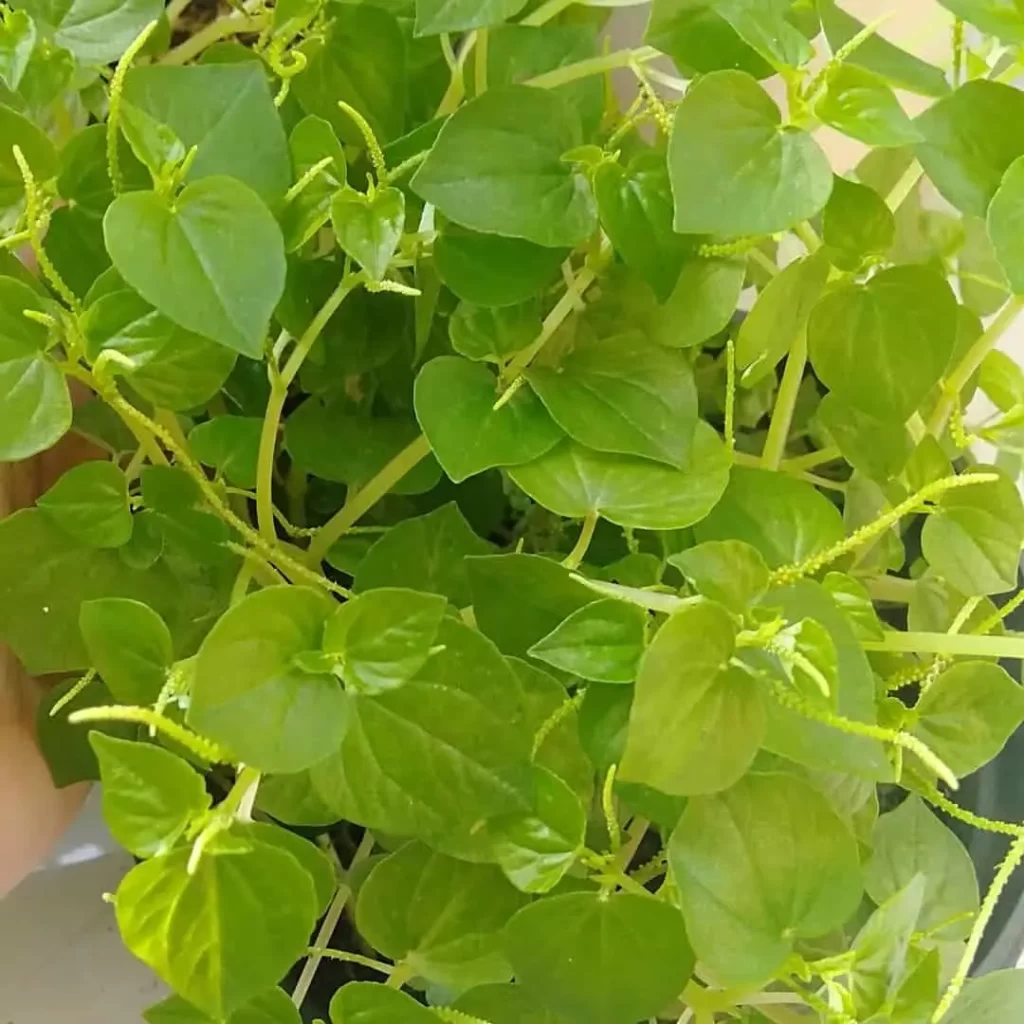
Peperomia pellucida, commonly known as Peperomia Brazilian, is a charming and visually appealing houseplant hailing from the tropical regions of Central and South America. It is a member of the Peperomia genus, known for its diverse and visually captivating foliage.
The Peperomia Brazilian is recognized for its distinctive, semi-translucent leaves. Each leaf possesses a glossy surface with a slightly waxy texture, giving it an elegant and delicate appearance. The leaves are typically medium to dark green in color, and they are often adorned with intricate patterns of silver, cream, or white variegation, adding to its visual appeal.
This particular Peperomia variety is a relatively compact plant, growing in a bushy, upright manner. It typically reaches a height of about 6 to 12 inches (15 to 30 centimeters), making it a suitable choice for small spaces, shelves, or as part of a plant arrangement.
10. Caespitosa
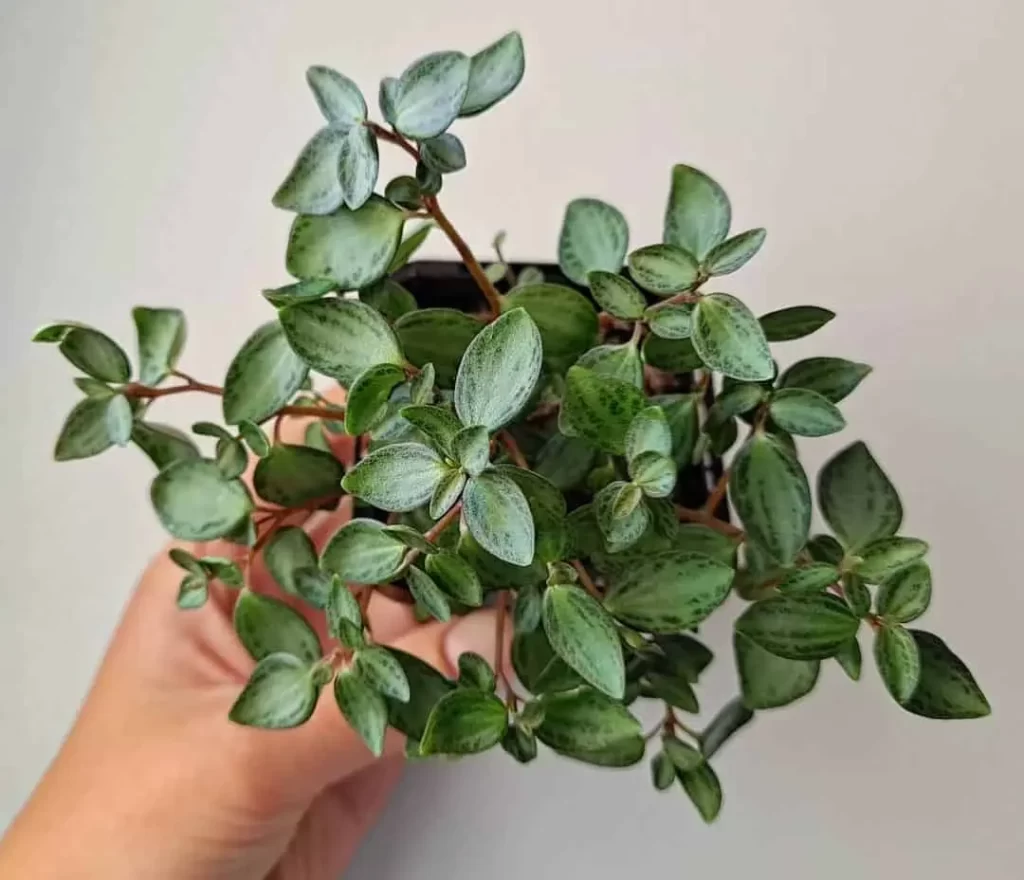
Peperomia caespitosa, also known as the Peperomia “Caespitosa,” is a delightful and compact succulent houseplant originating from the tropical regions of Central and South America. It belongs to the Peperomia genus, which is celebrated for its diverse and visually captivating foliage.
The Peperomia Caespitosa is recognized for its charming rosette-shaped clusters of succulent leaves. The leaves are typically oval or spoon-shaped, with a glossy texture, and they range in color from deep green to reddish-purple, often displaying intricate patterns or variegation. This gives the plant an eye-catching and visually appealing appearance.
In terms of size, this particular Peperomia variety remains relatively petite, growing in a low, mounding manner. It typically reaches a height of about 3 to 6 inches (7 to 15 centimeters), making it an ideal choice for small spaces, terrariums, or as part of a succulent arrangement.
11. Cilantro Leaf

The Peperomia Cilantro Leaf (Peperomia maculosa) gets its name from the resemblance of its leaves to cilantro leaves.
Its compact size and delicate foliage make it a charming addition to windowsills or small planters.
This variety thrives in low to moderate indirect light, making it suitable for indoor spaces with filtered sunlight.
Water when the top inch of soil is dry, ensuring adequate drainage.
12. Columbian
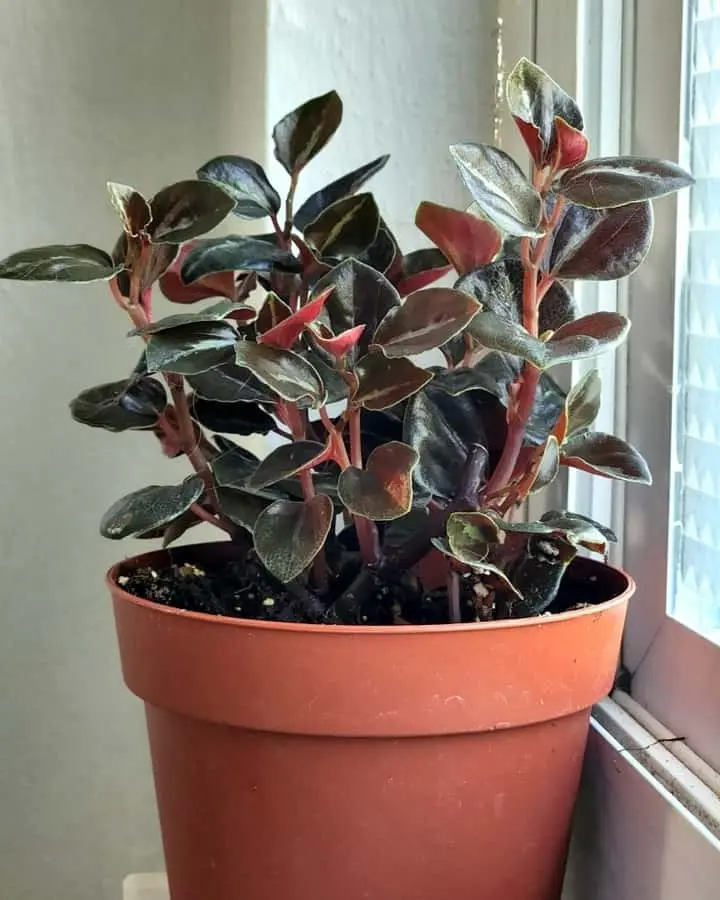
Peperomia metallica ‘Columbiana’, often referred to as the Columbian Peperomia, is an enchanting houseplant known for its striking metallic sheen and unique leaf patterns. This variety is a cultivar within the Peperomia genus, which is celebrated for its diverse and visually captivating foliage.
The Columbian Peperomia is named for its distinctive metallic appearance, with leaves that shimmer in shades of green, bronze, and silver. The foliage is elliptical in shape, with a slightly succulent texture, giving it a robust and lush appearance. The metallic sheen on the leaves is especially pronounced when it catches the light, adding to the visual appeal of the plant.
This particular Peperomia variety maintains a compact and bushy growth habit, typically reaching a height of about 6 to 10 inches (15 to 25 centimeters). Its manageable size makes it an excellent choice for small spaces, shelves, or as part of a plant arrangement.
13. Cupid

Peperomia scandens, commonly known as Peperomia Cupid, is a charming and popular trailing houseplant originating from the tropical regions of Central and South America. It belongs to the Peperomia genus, which is celebrated for its diverse and visually captivating foliage.
The Peperomia Cupid is recognized for its heart-shaped leaves, which grow on slender, cascading stems. The leaves are typically glossy and succulent-like, with a rich green color. This feature gives the plant an elegant and delicate appearance, making it a sought-after choice for hanging baskets or as a trailing accent in plant arrangements.
In terms of size, this particular Peperomia variety remains relatively compact, typically reaching a height of about 6 to 8 inches (15 to 20 centimeters) and spreading outwards as it trails. This makes it an ideal choice for small spaces or as a beautiful addition to your hanging plant collection.
14. Elongata
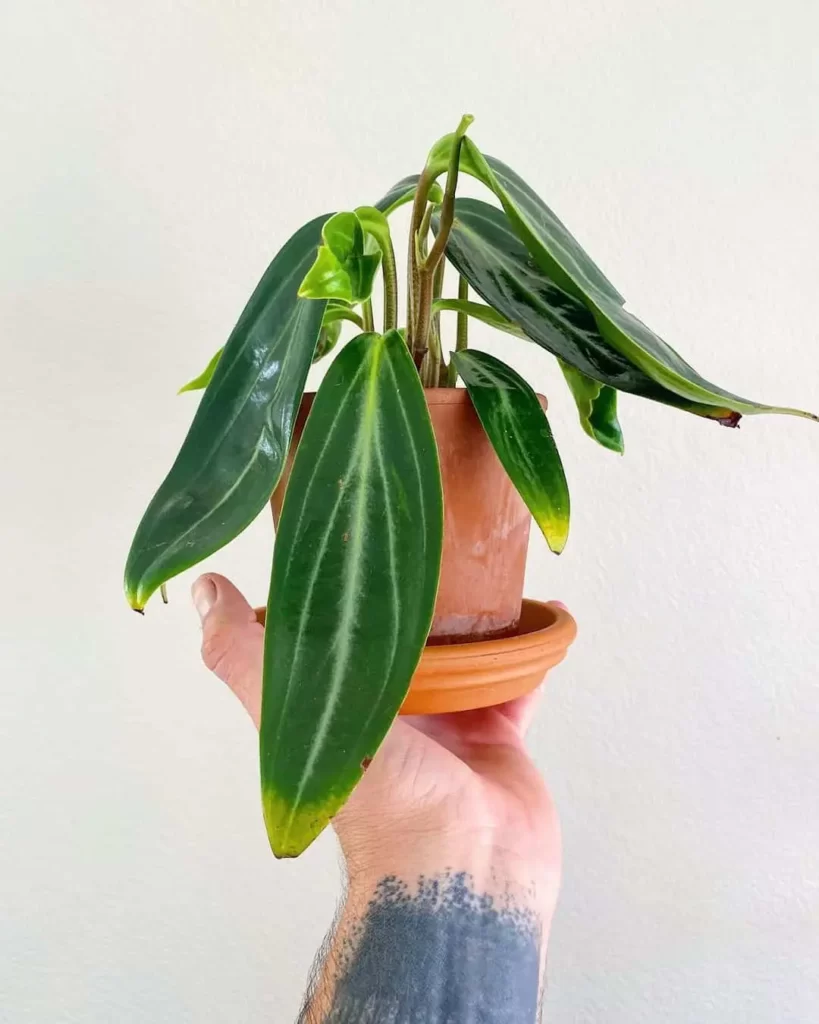
Peperomia elongata, commonly known as the Peperomia ‘Elongata,’ is an enchanting houseplant originating from the tropical regions of Central and South America. It is a member of the Peperomia genus, celebrated for its diverse and visually captivating foliage.
The Peperomia ‘Elongata’ is recognized for its slender, elongated leaves that are typically dark green and glossy. The leaves grow on upright stems, giving the plant a neat and organized appearance. This particular variety is known for its graceful and elegant leaf shape, which sets it apart from other Peperomia species.
In terms of size, Peperomia ‘Elongata’ remains relatively compact, typically reaching a height of about 8 to 12 inches (20 to 30 centimeters).
15. Emerald Ripple
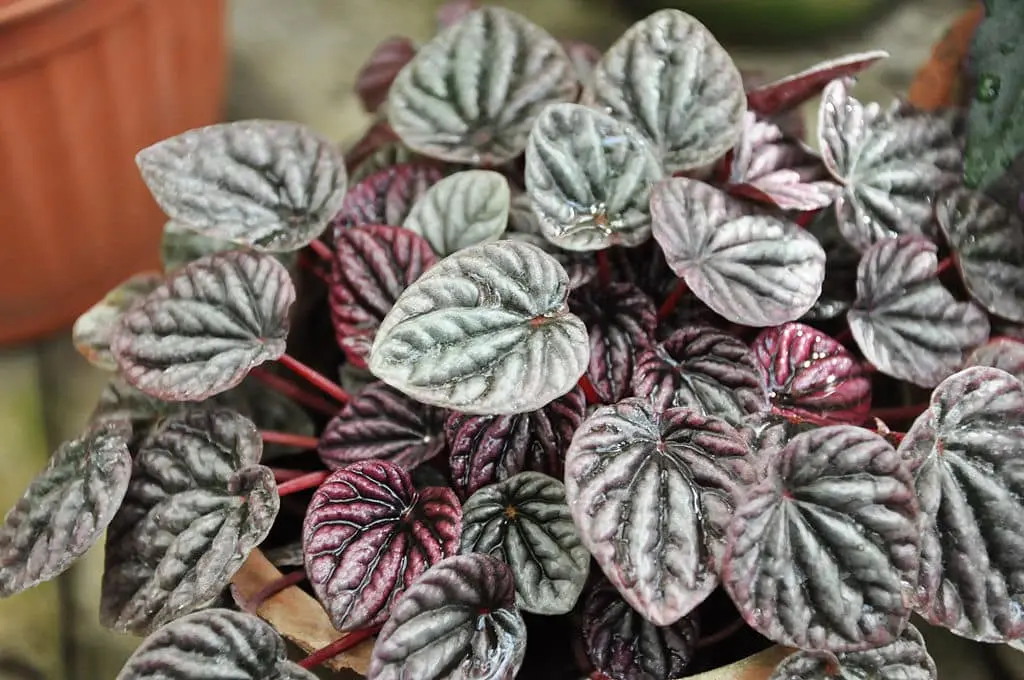
Peperomia caperata “Emerald Ripple,” commonly known as the Emerald Ripple Peperomia, is a captivating houseplant originating from the tropical regions of Brazil. It is a variety within the Peperomia genus, known for its diverse and visually captivating foliage.
The Emerald Ripple Peperomia is recognized for its deeply corrugated, heart-shaped leaves. These leaves are a rich, glossy green, and they have a rippled texture that gives them a unique and visually appealing appearance. The texture of the leaves is what lends the plant its distinctive name.
In terms of size, this particular Peperomia variety remains relatively compact, typically reaching a height of about 6 to 8 inches (15 to 20 centimeters).
16. Fagerlindii
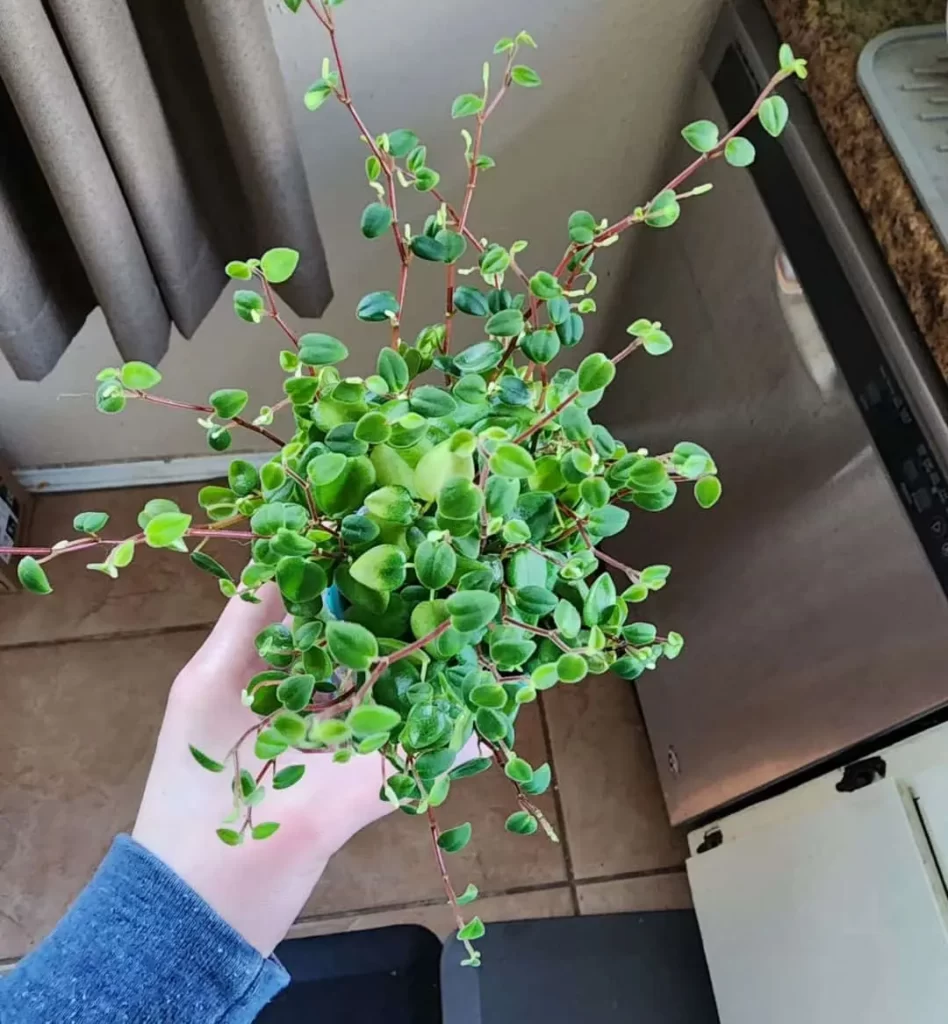
Peperomia fagerlindii, commonly known as Fagerlind’s Peperomia, is a unique and visually appealing houseplant hailing from the tropical regions of Central and South America. It is a member of the Peperomia genus, celebrated for its diverse and intriguing foliage.
Fagerlind’s Peperomia is recognized for its distinctive, heart-shaped leaves that are typically dark green with a glossy texture. The leaves are succulent-like, with prominent veining, giving them a lush and visually appealing appearance. This particular variety is characterized by its vibrant leaf color and shape, setting it apart from other Peperomia species.
In terms of size, Peperomia fagerlindii remains relatively compact, typically reaching a height of about 6 to 12 inches (15 to 30 centimeters).
17. Felted Pepperface
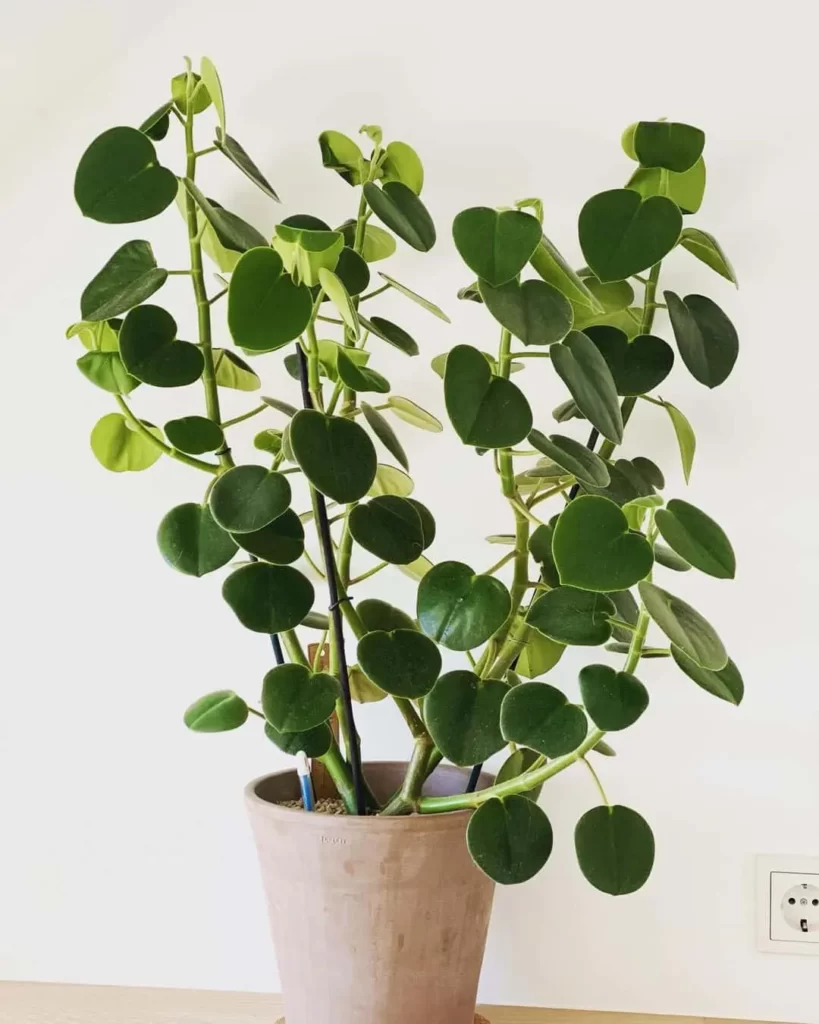
Peperomia incana, commonly known as the Felted Pepperface or Felted Peperomia, is an intriguing and visually appealing houseplant originating from the tropical regions of Central and South America. It is a member of the Peperomia genus, which is celebrated for its diverse and visually captivating foliage.
The Felted Pepperface is recognized for its distinctive, velvety leaves that are typically gray-green to silvery in color. The leaves have a fuzzy or felty texture, which is where the common name “Felted” comes from. This gives the plant a soft and tactile quality, adding to its unique appeal.
In terms of size, Peperomia incana remains relatively compact, typically reaching a height of about 6 to 10 inches (15 to 25 centimeters).
18. Flowering
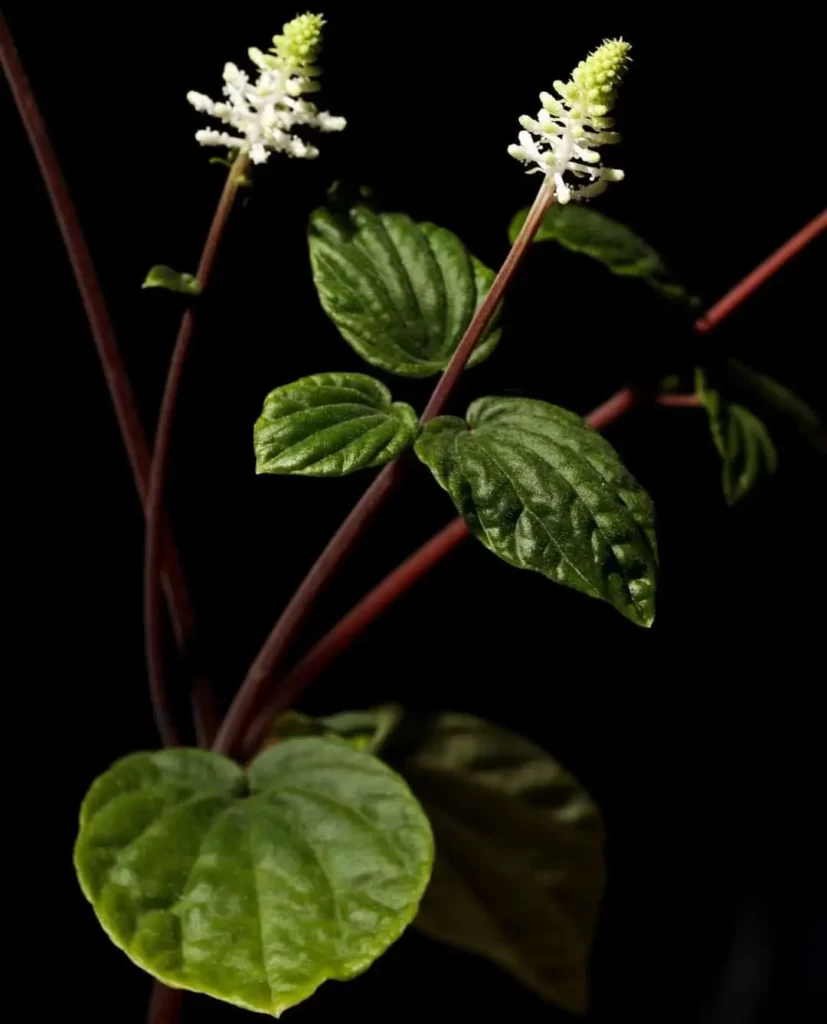
Peperomia fraseri, commonly known as Flowering Peperomia, is a charming and visually appealing houseplant originating from the tropical regions of Central and South America. It belongs to the Peperomia genus, which is celebrated for its diverse and visually captivating foliage.
Despite its common name, the Flowering Peperomia is primarily grown for its attractive foliage rather than its blooms. The plant features small, lance-shaped leaves that are typically dark green and have a glossy texture. The leaves grow in a rosette-like arrangement, giving the plant a neat and organized appearance. While the flowers are relatively inconspicuous, they may appear as small, white spikes rising above the foliage under the right conditions.
In terms of size, Peperomia fraseri remains relatively compact, typically reaching a height of about 6 to 12 inches (15 to 30 centimeters).
19. Frost
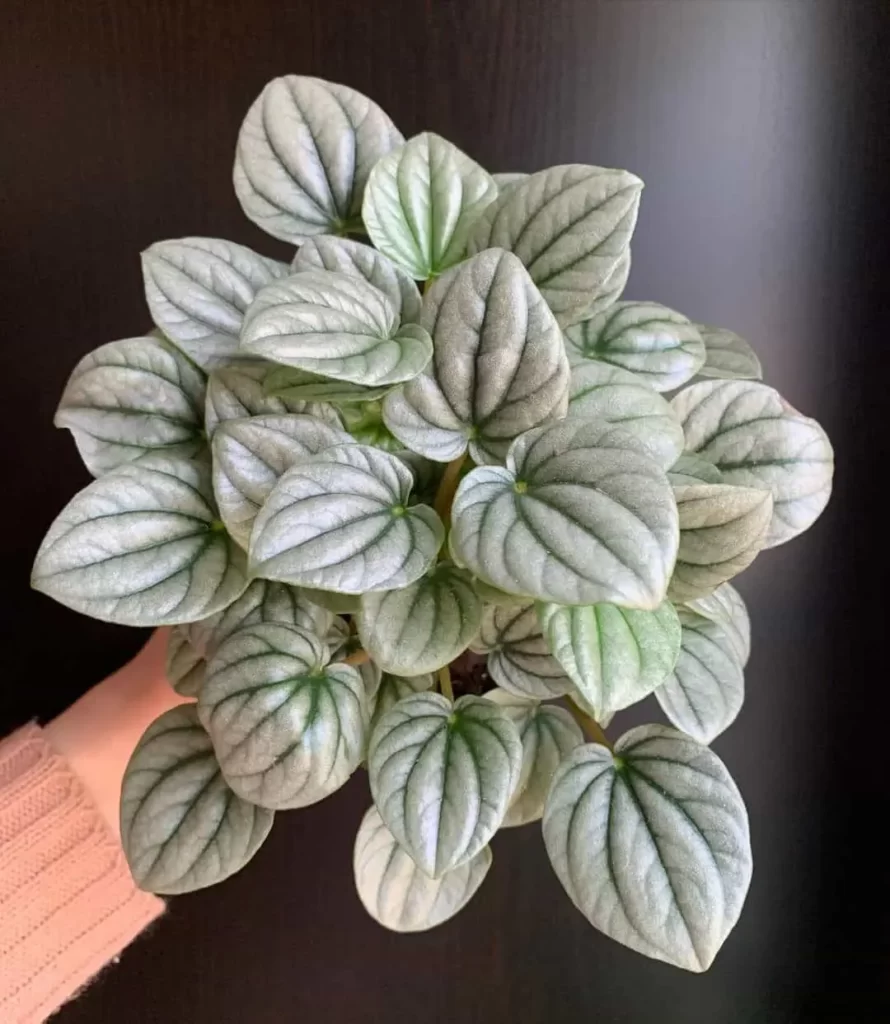
Peperomia caperata ‘Frost’, commonly known as Frost Peperomia, is a captivating cultivar of the Peperomia caperata species. This unique houseplant is native to the tropical regions of South America. It is cherished for its intriguing and visually appealing foliage.
The Frost Peperomia is recognized for its deeply corrugated, heart-shaped leaves. What sets this variety apart is the silvery-gray pattern that adorns the leaves, resembling a frost-like texture, hence its name. This striking feature gives the plant a distinctive and eye-catching appearance.
In terms of size, Peperomia caperata ‘Frost’ remains relatively compact, typically reaching a height of about 6 to 8 inches (15 to 20 centimeters).
20. Fuzzy Mystery
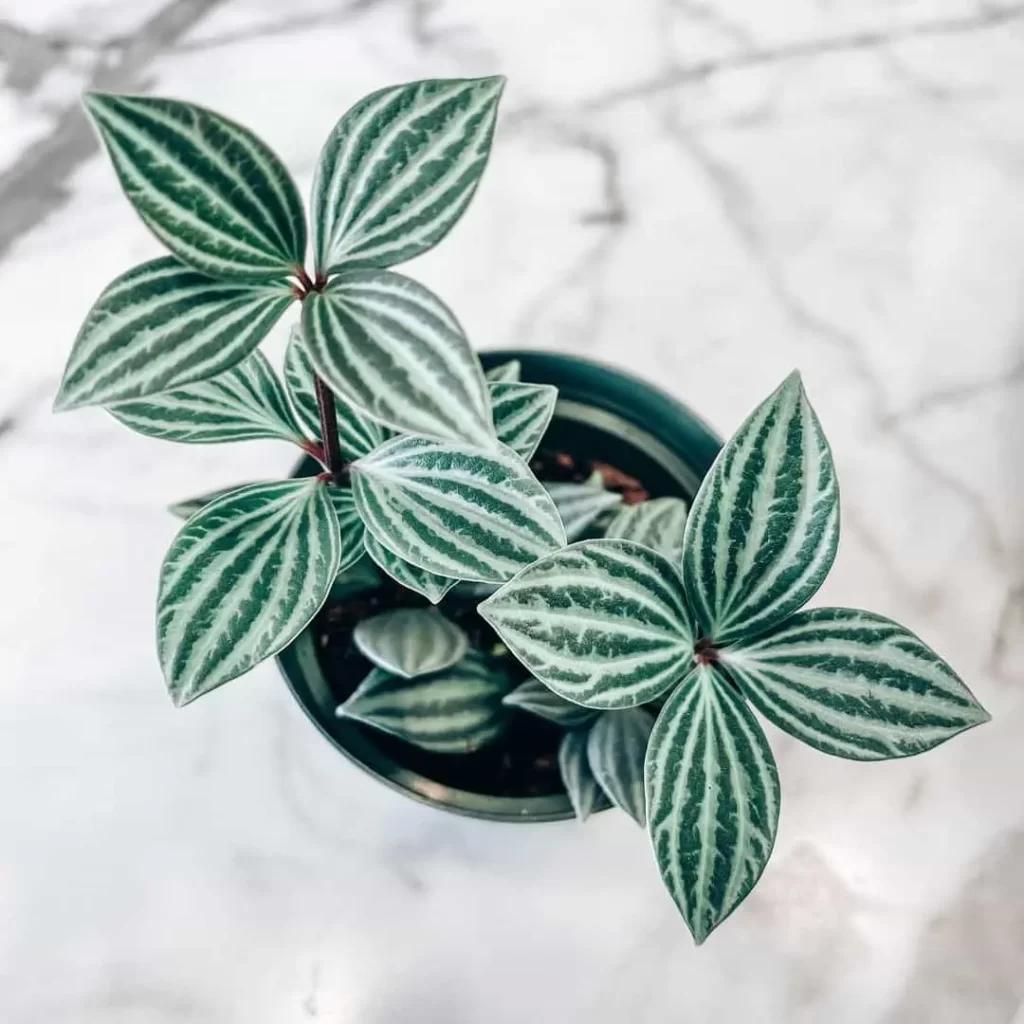
Peperomia puteolata, commonly known as Fuzzy Mystery Peperomia, is an intriguing and visually appealing houseplant originating from the tropical regions of Central and South America. It is a member of the Peperomia genus, celebrated for its diverse and visually captivating foliage.
The Fuzzy Mystery Peperomia is recognized for its distinctive, lance-shaped leaves that are typically dark green and have a slightly fuzzy or velvety texture. This characteristic gives the plant a soft and tactile quality, adding to its unique appeal. The leaves are often adorned with interesting patterns or variegation, further enhancing its visual interest.
In terms of size, Peperomia puteolata remains relatively compact, typically reaching a height of about 6 to 8 inches (15 to 20 centimeters).
21. Golden Gate
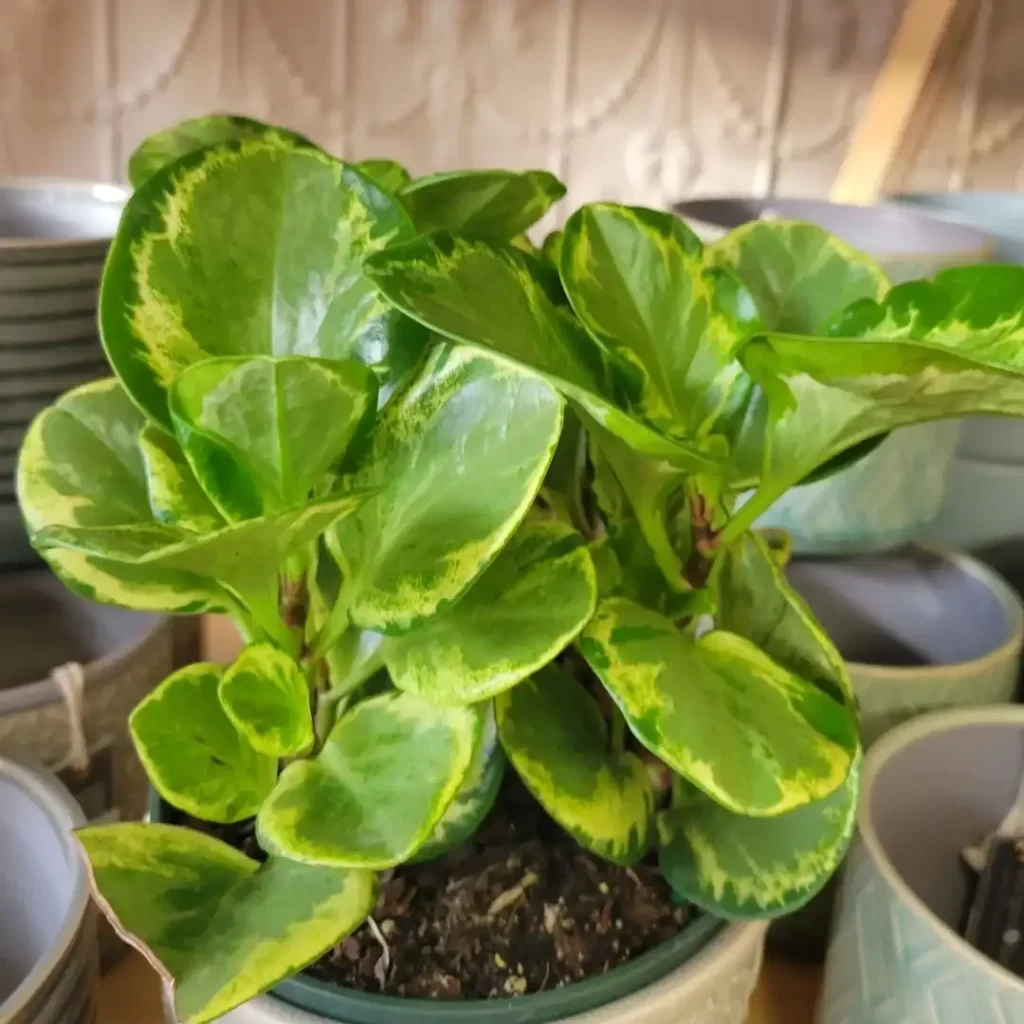
Peperomia Golden Gate, scientifically known as Peperomia obtusifolia ‘Golden Gate’, is a popular and visually appealing houseplant known for its striking variegated foliage. It belongs to the Peperomia genus, which is celebrated for its diverse and visually captivating leaves.
The Golden Gate variety is recognized for its heart-shaped leaves that display a captivating blend of dark green and creamy-white or yellowish patterns. This striking contrast creates a visually arresting effect, making it a standout addition to any indoor plant collection.
In terms of size, the Peperomia Golden Gate remains relatively compact, typically reaching a height of about 8 to 12 inches (20 to 30 centimeters).
22. Happy Bean
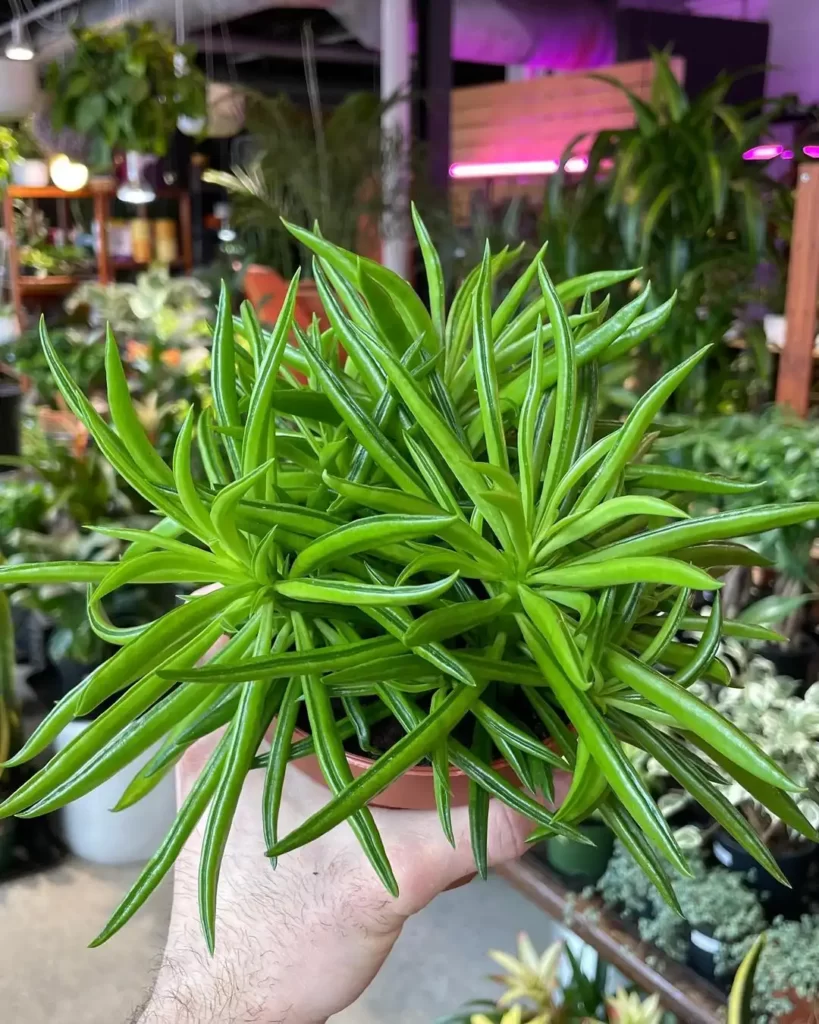
Peperomia ferreyrae, commonly known as Happy Bean or Pincushion Peperomia, is a charming and visually appealing succulent houseplant native to arid regions of Peru. It is a member of the Peperomia genus, known for its diverse and intriguing foliage.
The Happy Bean is recognized for its slender, cylindrical leaves that resemble little beans or beads. The leaves are typically light green and have a unique succulent texture, giving them a plump and fleshy appearance. This distinctive feature sets it apart from many other Peperomia species.
In terms of size, Peperomia ferreyrae remains relatively compact, typically reaching a height of about 6 to 8 inches (15 to 20 centimeters). Its manageable size makes it an excellent choice for small spaces, shelves, or as part of a succulent arrangement.
23. Hope
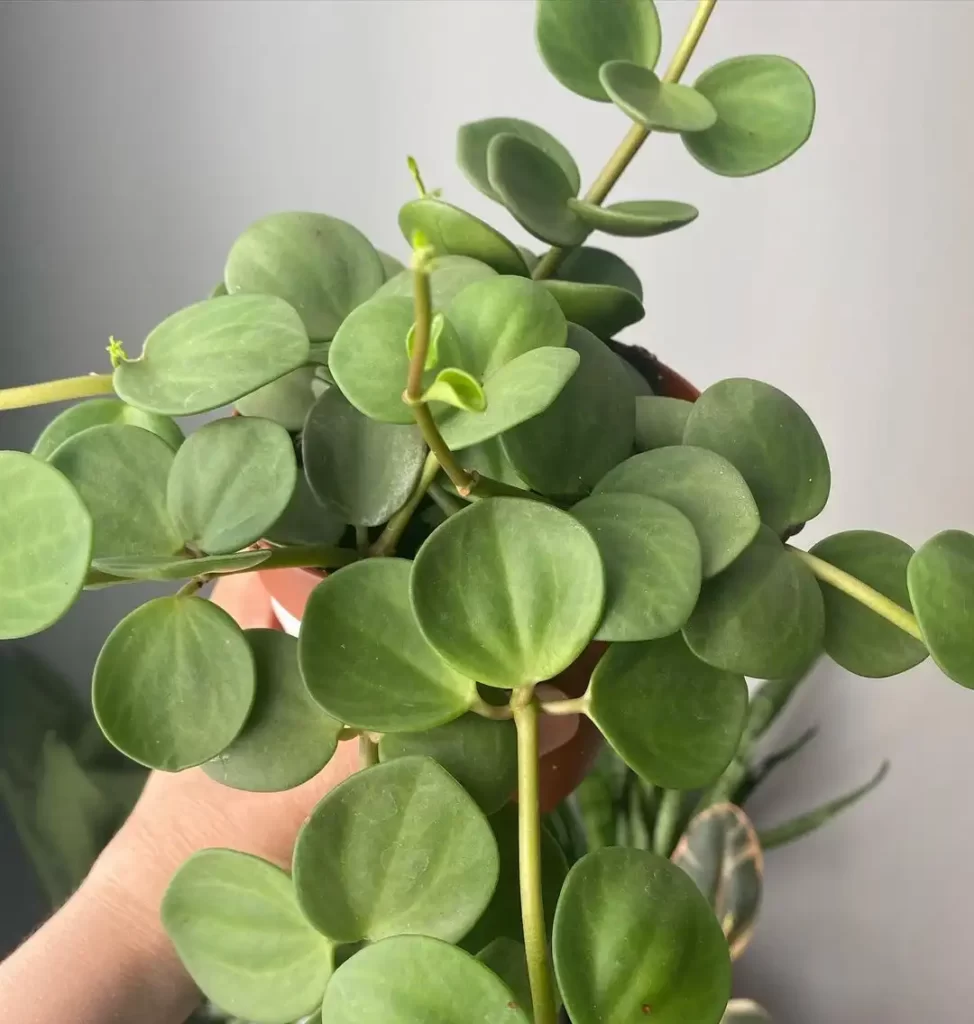
Peperomia tetraphylla, commonly known as Peperomia Hope, is a delightful and visually appealing houseplant native to the tropical regions of Central and South America. It belongs to the Peperomia genus, celebrated for its diverse and visually captivating foliage.
Peperomia Hope is recognized for its unique foliage, which features small, rounded leaves arranged in clusters of four. The leaves are typically bright green and have a slightly succulent texture, giving them a plump and fleshy appearance. This particular variety is characterized by its charming leaf arrangement, which sets it apart from many other Peperomia species.
In terms of size, Peperomia tetraphylla remains relatively compact, typically reaching a height of about 6 to 8 inches (15 to 20 centimeters).
24. Hutchisonii
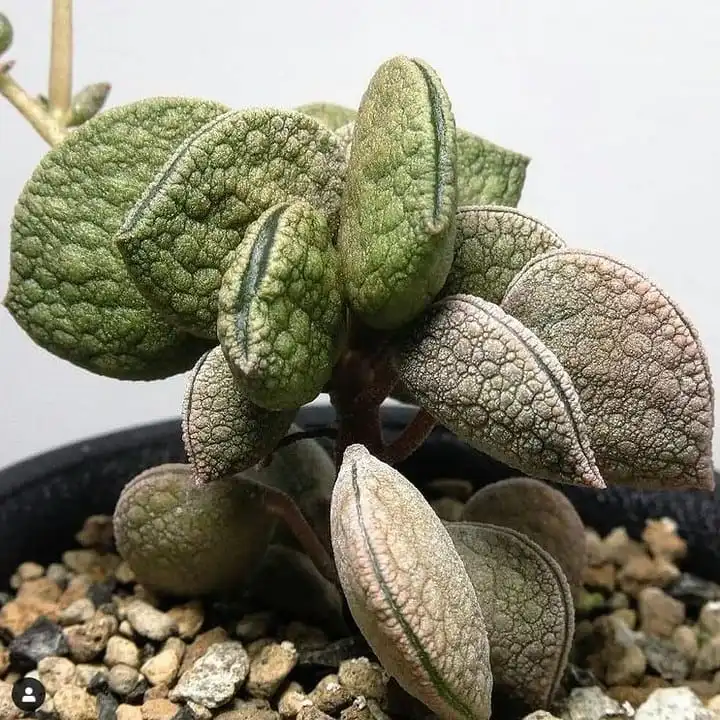
Peperomia hutchisonii is a delightful and visually appealing houseplant originating from the tropical regions of Central and South America. It is a member of the Peperomia genus, celebrated for its diverse and visually captivating foliage.
The Peperomia hutchisonii is recognized for its striking variegated leaves. Each leaf displays a mesmerizing pattern of light and dark green hues, creating a visually arresting effect. The leaves are generally small, thick, and have a slightly succulent texture, which is a common trait in many Peperomia species.
The plant typically grows in a compact, bushy manner, reaching a height of around 8 to 12 inches (20 to 30 centimeters).
25. Isabella
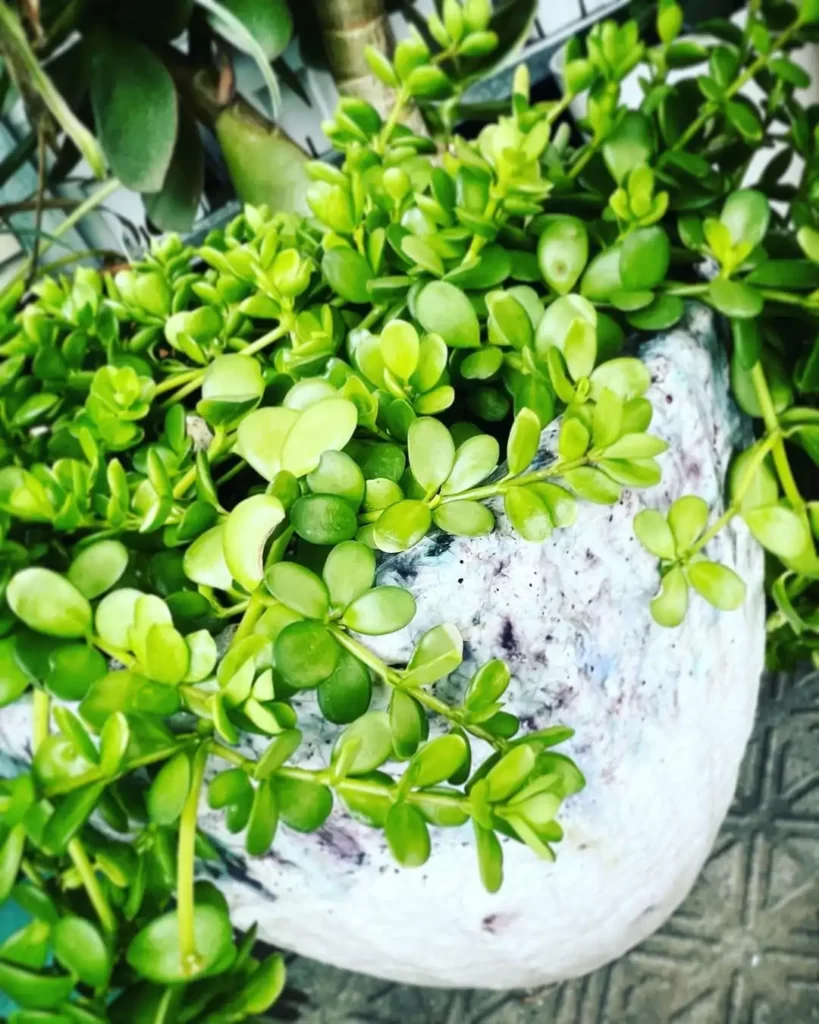
Peperomia isabella, commonly known as Isabella Peperomia, is a charming and visually appealing houseplant native to the tropical regions of Central and South America. It is a member of the Peperomia genus, celebrated for its diverse and intriguing foliage.
The Isabella Peperomia is recognized for its unique leaf shape and coloration. The leaves are typically a rich, dark green with a glossy texture. They are oval-shaped with pronounced venation, giving them an elegant and visually captivating appearance. This particular variety is characterized by its graceful leaf form.
In terms of size, Peperomia isabella remains relatively compact, typically reaching a height of about 6 to 10 inches (15 to 25 centimeters).
26. Itsy Bitsy
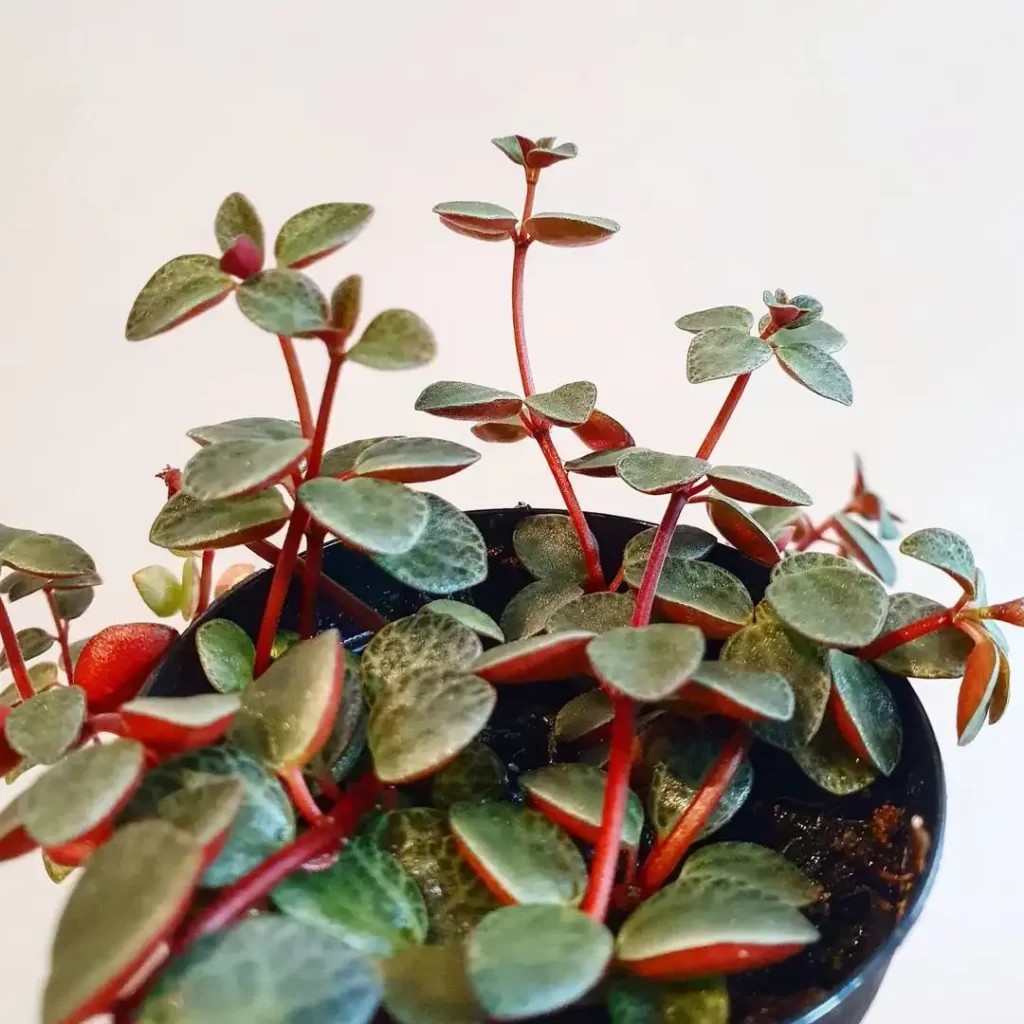
Peperomia ‘Itsy Bitsy’ is a distinctive and rare variant of the Peperomia family, native to Jamaica. What sets it apart are its striking red stems and vibrant scarlet red undersides of the leaves. This unique coloration makes it stand out among other Peperomia varieties.
Unlike many of its relatives, Peperomia ‘Itsy Bitsy’ requires a bit more direct sunlight, ideally between one to three hours daily. This makes it important to find a suitable spot with adequate but not excessive light.
When it comes to watering, it’s crucial to strike a balance. The soil should be kept consistently moist, but not overly saturated. Overwatering can be detrimental to this plant, so it’s important to exercise caution and avoid letting it sit in waterlogged conditions.
With its distinctive appearance and specific care requirements, Peperomia ‘Itsy Bitsy’ can be a captivating addition to any plant collection. Providing the right balance of light and moisture will help it thrive and become a unique highlight in your indoor garden.
27. Jayde
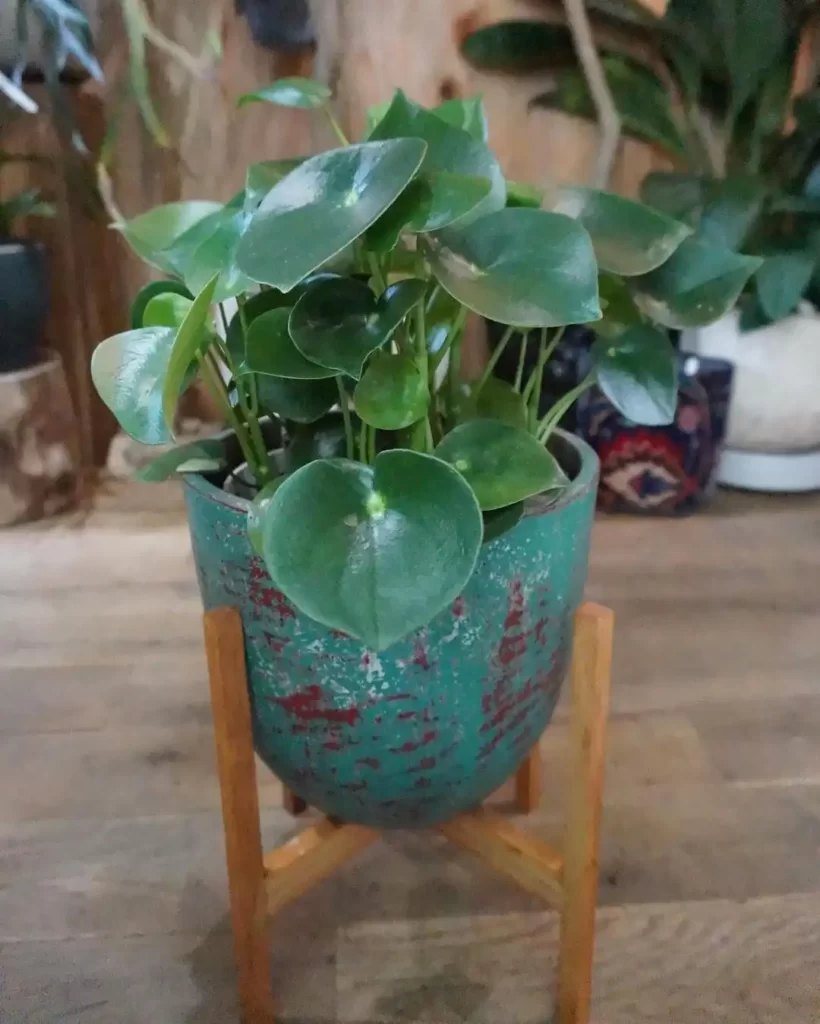
The Jayde Peperomia, also known as the Coin Leaf Peperomia or Owl Eye Peperomia, is a charming succulent with unique foliage.
Caring for this plant is relatively simple. It thrives in partial or dappled shade, making it an ideal choice for indoor settings. When potting it, ensure you use well-draining soil to prevent overwatering.
It’s important to be cautious with sunlight exposure, as the Jayde Peperomia can be sensitive. Avoid placing it in direct sunlight, and instead, choose a spot where it can receive indirect light.
Regarding watering, it’s recommended to water this plant sparingly. While a weekly watering is suggested, it can tolerate longer periods between waterings. This plant has a good tolerance for drought, meaning it can survive with minimal moisture for extended periods.
Overwatering can be detrimental to the Jayde Peperomia, potentially leading to issues like root rot. Therefore, it’s better to err on the side of underwatering than overwatering with this particular succulent.
28. Jelly
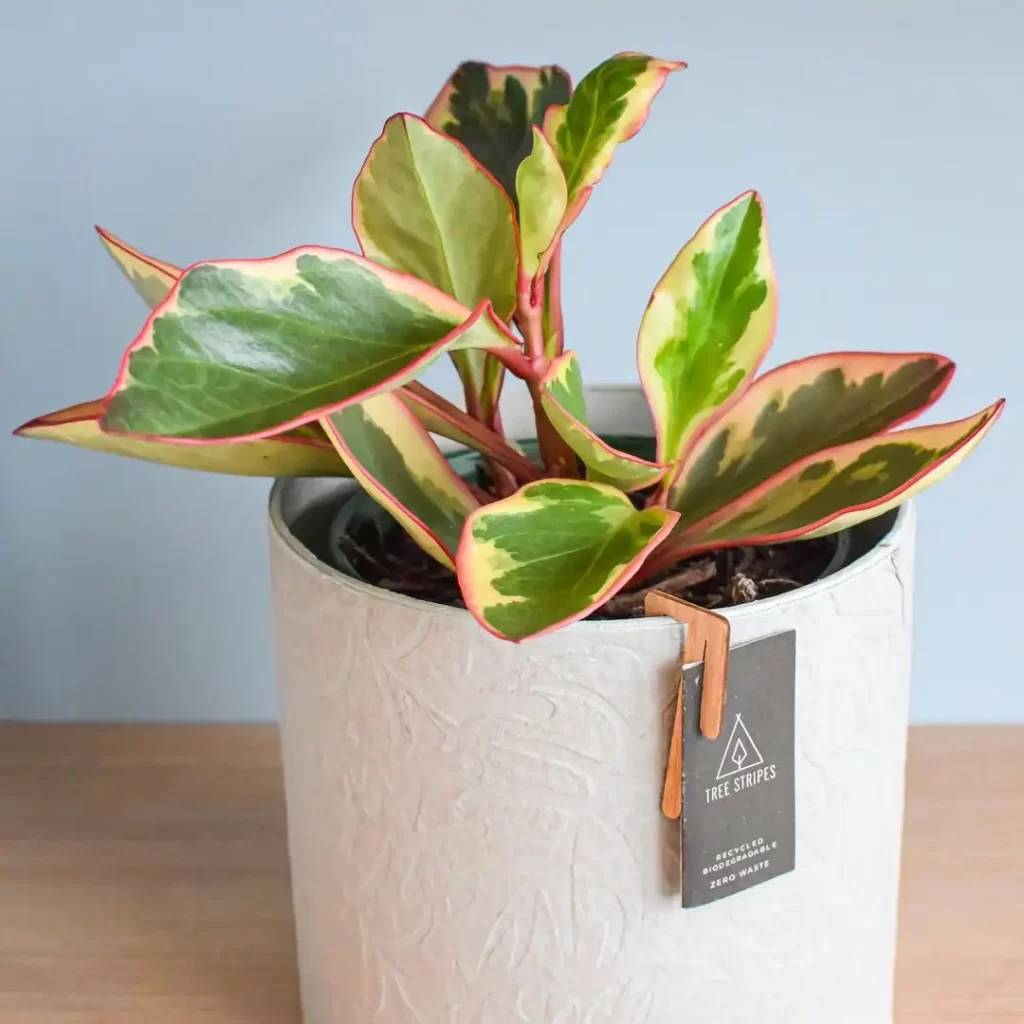
Peperomia Jelly, also known as Peperomia Clusiifolia ‘Jelly,’ is a captivating and visually appealing houseplant originating from the tropical regions of Central and South America. It belongs to the Peperomia genus, celebrated for its diverse and intriguing foliage.
The Peperomia Jelly is recognized for its striking, translucent leaves that have a unique jelly-like appearance. The leaves are typically green with a semi-translucent quality, giving them a distinctive and visually captivating look. This particular variety is characterized by its enchanting leaf texture and coloration.
In terms of size, Peperomia Jelly remains relatively compact, typically reaching a height of about 8 to 12 inches (20 to 30 centimeters).
29. Metallic

Peperomia rosso, commonly known as Metallic Peperomia, is a captivating and visually appealing houseplant native to the tropical regions of South America. It belongs to the Peperomia genus, celebrated for its diverse and visually captivating foliage.
The Metallic Peperomia is recognized for its striking, metallic-like leaves that have a unique shimmering quality. The leaves are typically a mix of dark green and metallic bronze, giving them a distinctive and visually captivating appearance. This particular variety is characterized by its enchanting leaf coloration and texture.
In terms of size, Peperomia rosso remains relatively compact, typically reaching a height of about 6 to 8 inches (15 to 20 centimeters).
30. Monticola
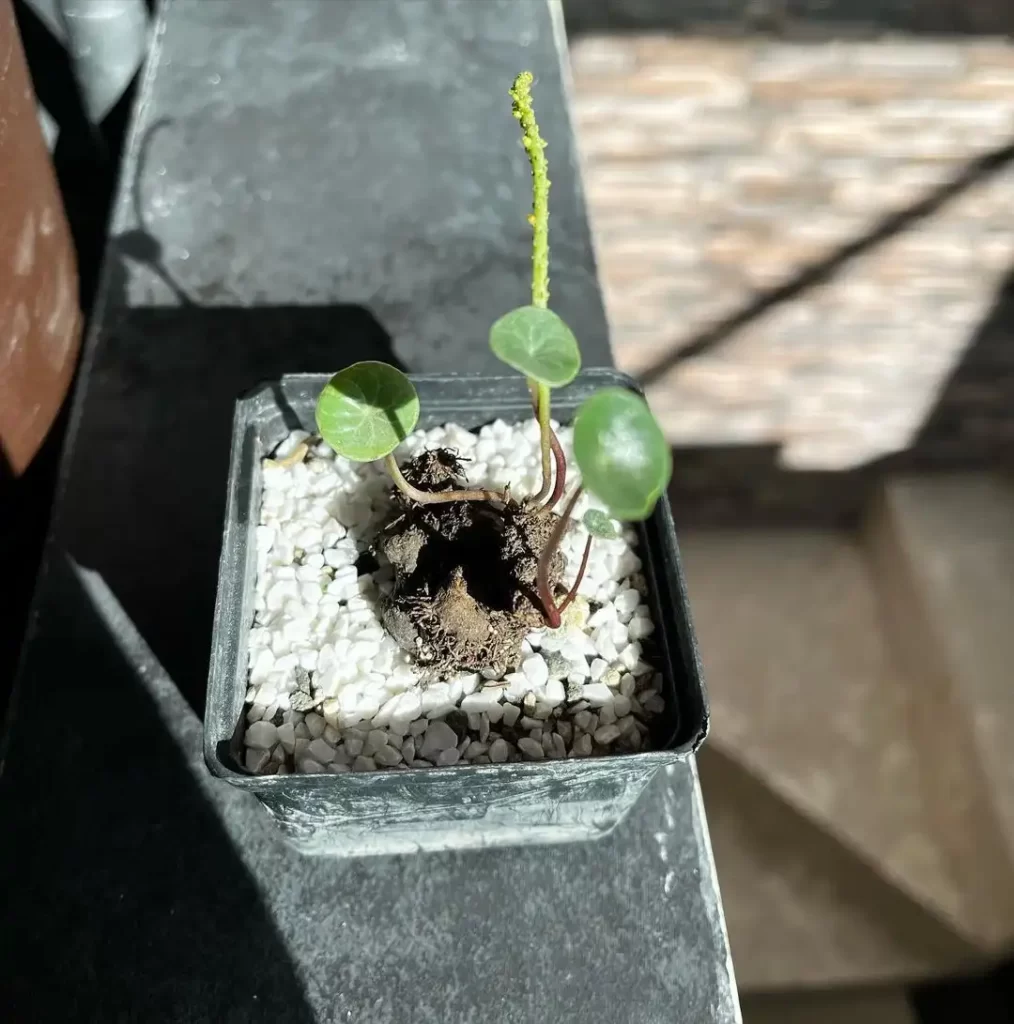
Peperomia Monticola is a petite plant, distinguishable by its smaller size compared to some other Peperomia varieties. Unlike those with prolific foliage, the Monticola features fewer, rounder leaves on delicate, trailing stems.
This plant is native to a wide range of regions in Mexico, often thriving in arid environments. However, it’s crucial to note that its leaves can dehydrate swiftly in excessively dry and hot conditions. Therefore, placing it in a spot with indirect sunlight is crucial to its well-being.
When it comes to watering, it’s important to strike a balance. While overwatering should be avoided, allowing the plant to dry out completely isn’t advisable either. Instead, wait until the top layer of soil has dried out before giving it a thorough but measured watering. This ensures that the plant remains adequately hydrated without risking waterlogging.
By providing these specific conditions, you’ll help your Peperomia Monticola thrive and maintain its charming appearance.
31. Orba
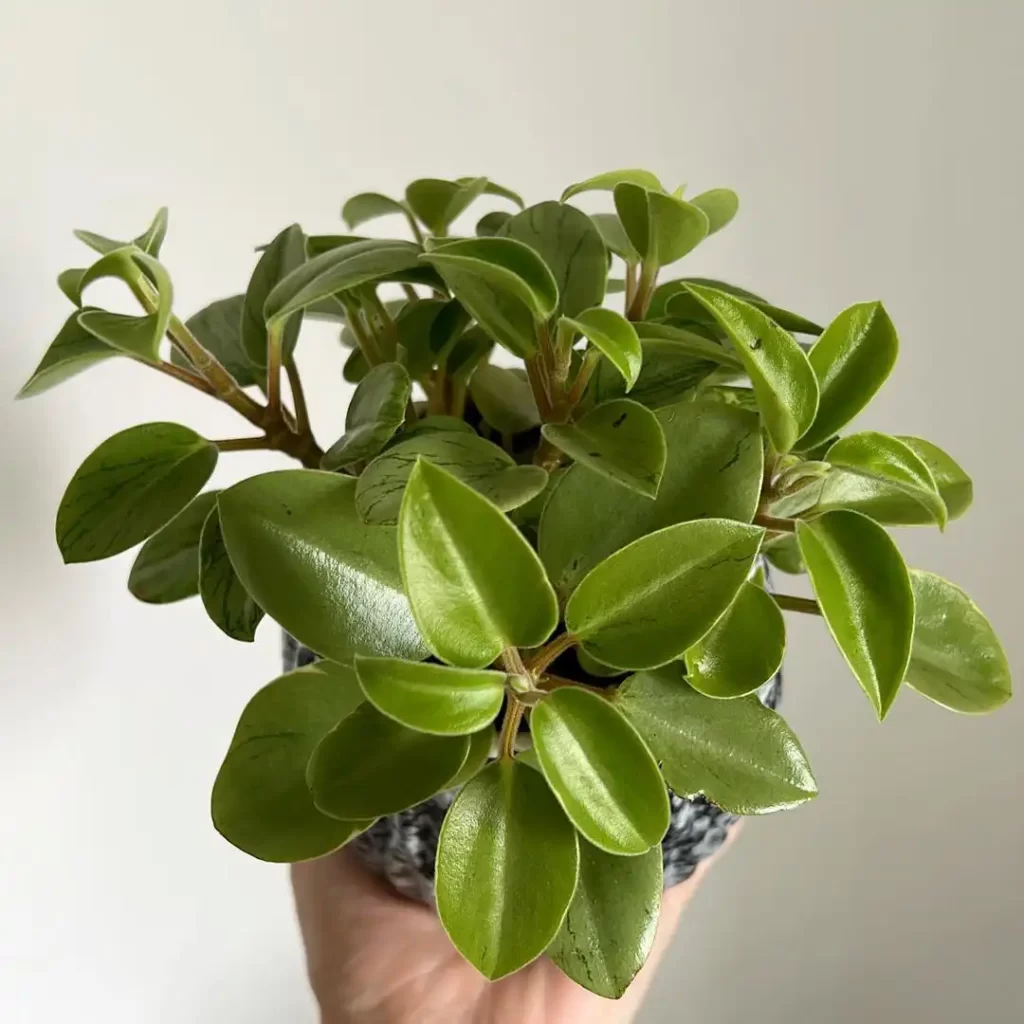
Peperomia orba, commonly known as Pixie Peperomia, is a charming and visually appealing houseplant native to the tropical regions of Central and South America. It is a member of the Peperomia genus, celebrated for its diverse and intriguing foliage.
The Pixie Peperomia is recognized for its small, round leaves that are typically dark green and have a slightly succulent texture, giving them a plump and fleshy appearance. This particular variety is characterized by its petite leaf size and compact growth habit.
In terms of size, Peperomia orba remains relatively small, typically reaching a height of about 6 to 8 inches (15 to 20 centimeters).
32. Panama
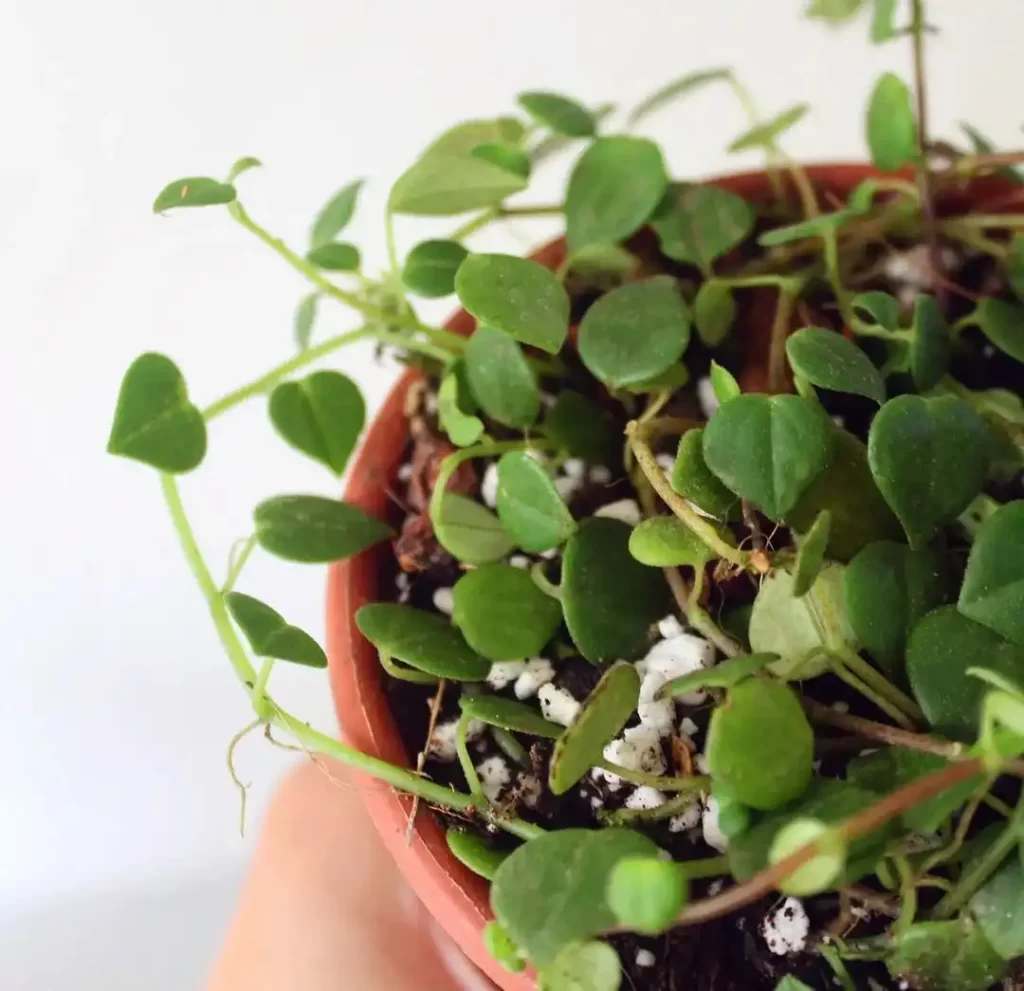
Peperomia perciliata, commonly known as Panama Peperomia, is a delightful and visually appealing houseplant native to the tropical regions of Central and South America. It is a member of the Peperomia genus, celebrated for its diverse and intriguing foliage.
The Panama Peperomia is recognized for its small, heart-shaped leaves that are typically dark green with a velvety texture. The leaves are often adorned with silver or metallic markings, adding to its visual appeal. This particular variety is characterized by its charming leaf shape and distinctive texture.
In terms of size, Peperomia perciliata remains relatively compact, typically reaching a height of about 6 to 8 inches (15 to 20 centimeters).
33. Parallel
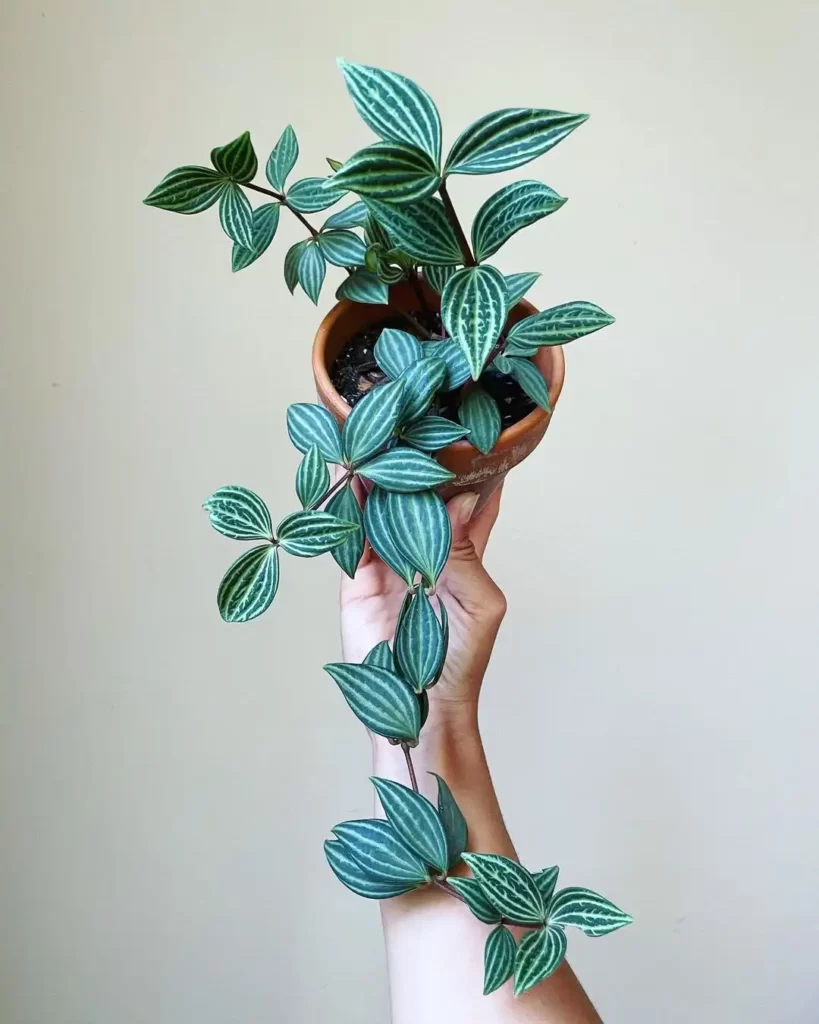
Peperomia tetragona, commonly known as Parallel Peperomia, is a captivating and visually appealing houseplant native to the tropical regions of Central and South America. It is a member of the Peperomia genus, celebrated for its diverse and intriguing foliage.
The Parallel Peperomia is recognized for its slender, upright stems that bear small, cylindrical leaves. The leaves are typically a deep green and have a succulent-like texture, giving them a plump and fleshy appearance. This particular variety is characterized by its unique leaf arrangement, which gives the impression of parallel lines along the stems.
In terms of size, Peperomia tetragona remains relatively compact, typically reaching a height of about 6 to 12 inches (15 to 30 centimeters).
34. Peacock
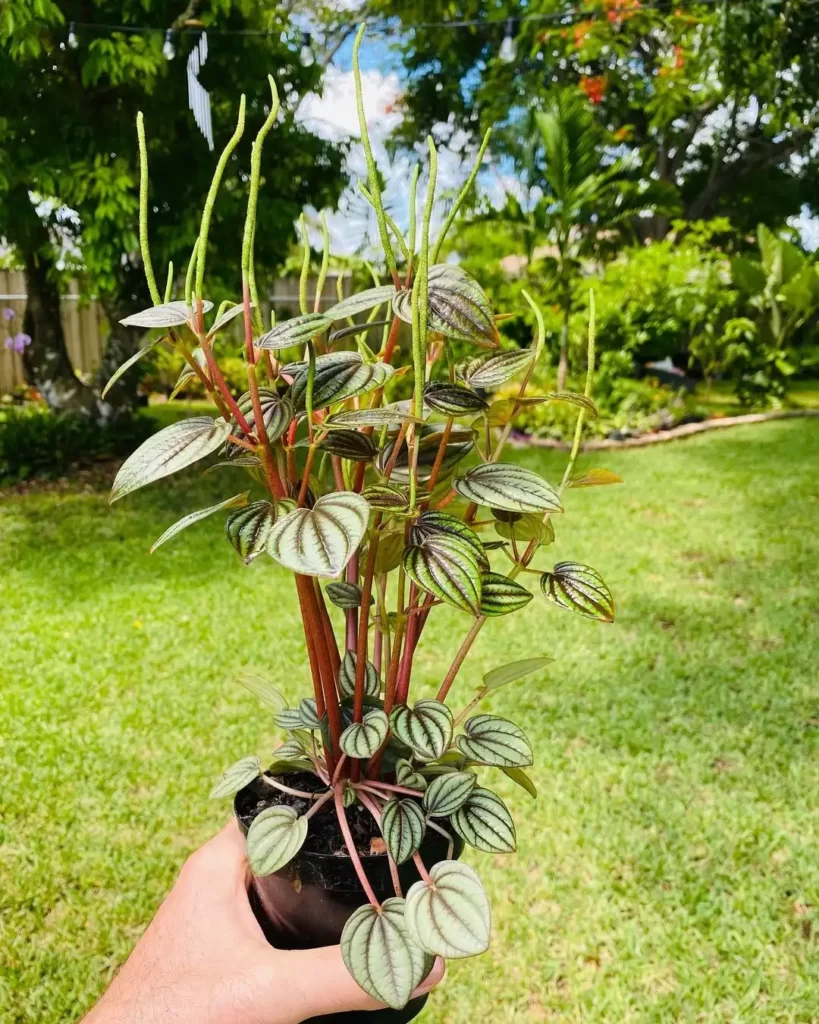
Peperomia albovittata, commonly known as Peacock Peperomia, is a captivating and visually appealing houseplant originating from the tropical regions of Central and South America. It belongs to the Peperomia genus, celebrated for its diverse and intriguing foliage.
The Peacock Peperomia is recognized for its striking, variegated leaves. Each leaf displays a mesmerizing pattern of dark green and silvery-white stripes, creating a visually arresting effect reminiscent of a peacock’s feathers. This particular variety is characterized by its enchanting leaf coloration and distinctive texture.
In terms of size, Peperomia albovittata remains relatively compact, typically reaching a height of about 6 to 10 inches (15 to 25 centimeters).
35. Pearly
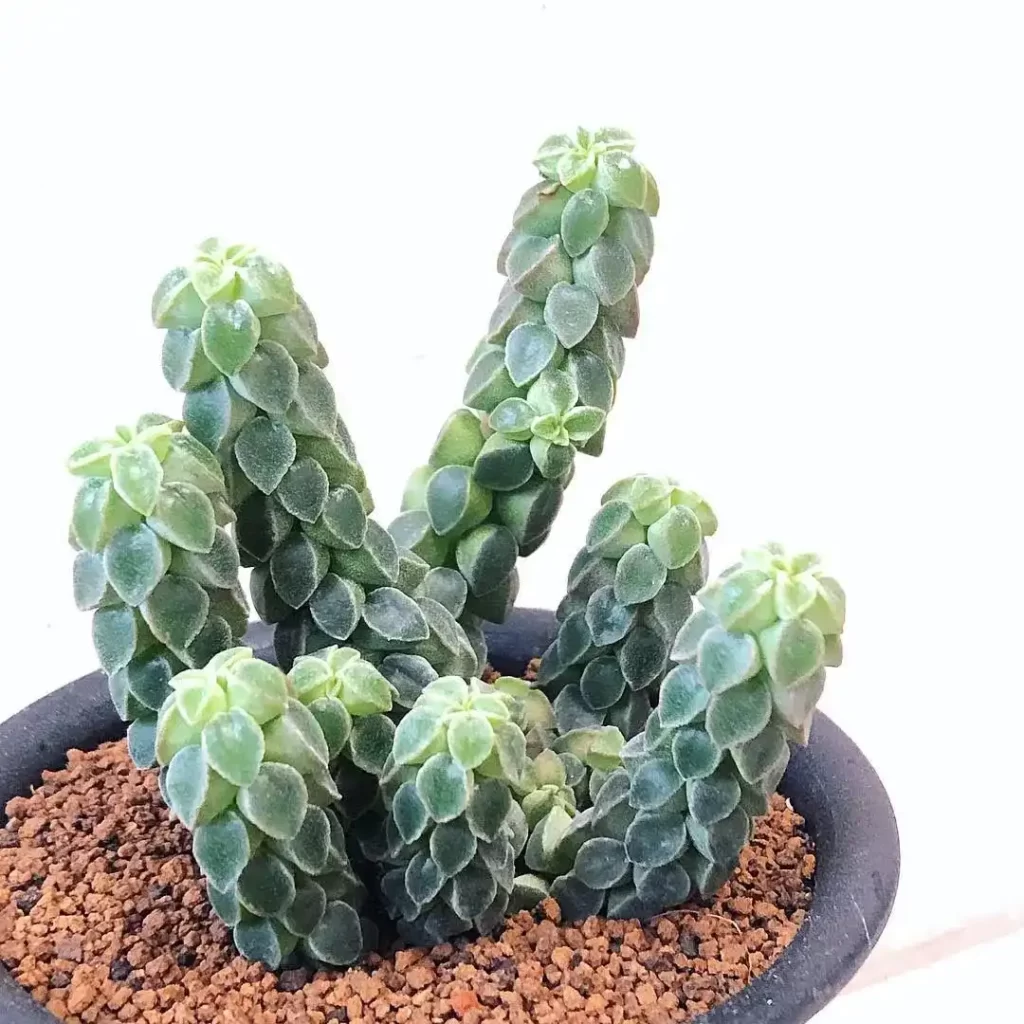
Peperomia columella, commonly known as Pearly Peperomia, is a charming and visually appealing houseplant originating from the tropical regions of Central and South America. It is a member of the Peperomia genus, celebrated for its diverse and intriguing foliage.
The Pearly Peperomia is recognized for its unique leaf arrangement. The leaves are small, succulent, and typically cylindrical, giving them a distinctive and visually captivating appearance. They are often a light green color, and their shape is reminiscent of tiny pearls, which is how this plant earned its common name.
In terms of size, Peperomia columella remains relatively compact, typically reaching a height of about 6 to 8 inches (15 to 20 centimeters).
36. Pereskiifolia

Peperomia pereskiifolia, also known as Pereskiifolia Peperomia, is a distinctive and visually appealing houseplant originating from the tropical regions of Central and South America. It belongs to the Peperomia genus, celebrated for its diverse and intriguing foliage.
The Pereskiifolia Peperomia is recognized for its unique leaf shape and coloration. The leaves are typically a rich, dark green with a glossy texture. They are elongated and have prominent veins, giving them an elegant and visually captivating appearance. This particular variety is characterized by its graceful leaf form.
In terms of size, Peperomia pereskiifolia remains relatively compact, typically reaching a height of about 6 to 8 inches (15 to 20 centimeters).
37. Piccolo Banda
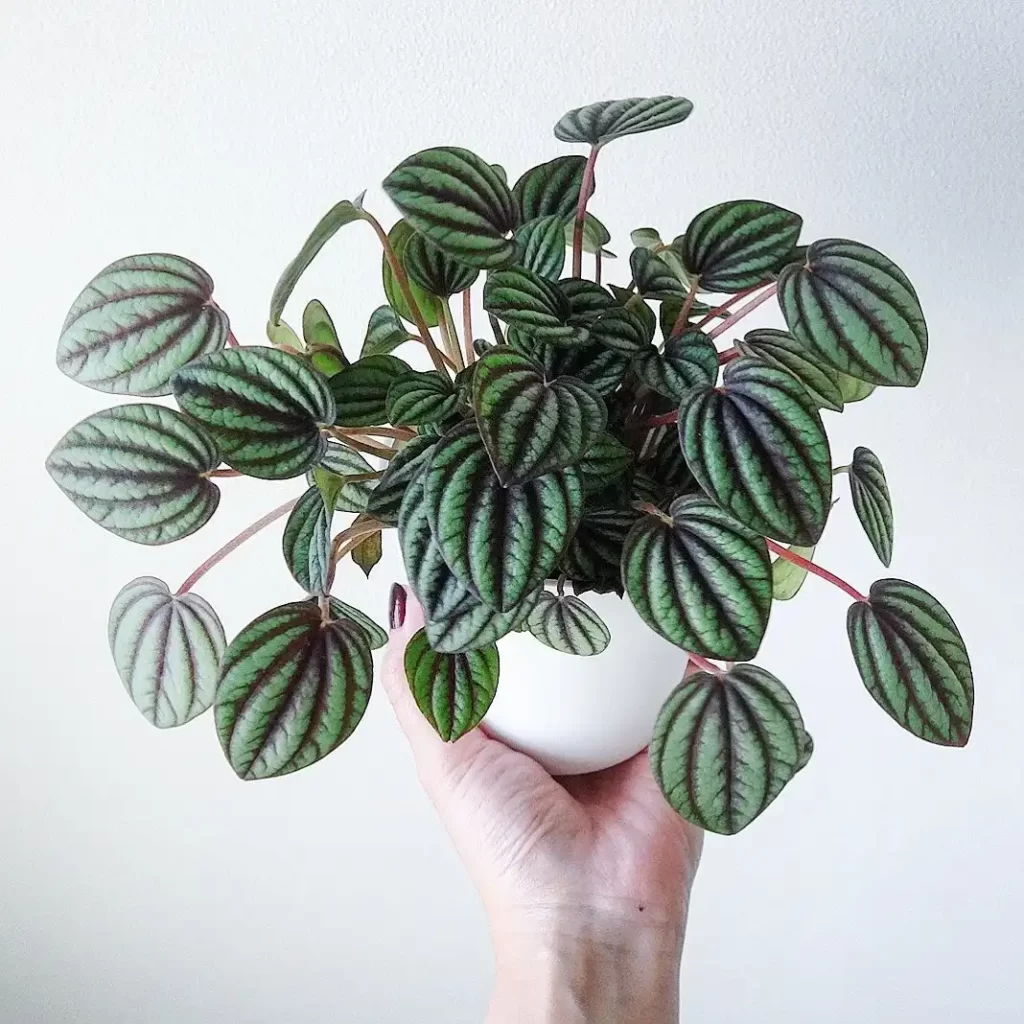
Peperomia albovittata ‘Piccolo Banda’, commonly known as Piccolo Banda Peperomia, is a captivating and visually appealing houseplant originating from the tropical regions of Central and South America. It is a cultivar of the Peperomia albovittata species, which is celebrated for its diverse and intriguing foliage.
The Piccolo Banda Peperomia is recognized for its striking, variegated leaves. Each leaf displays a mesmerizing pattern of dark green and silvery-white stripes, creating a visually arresting effect. This particular cultivar is characterized by its enchanting leaf coloration and distinctive texture.
In terms of size, Peperomia albovittata ‘Piccolo Banda’ remains relatively compact, typically reaching a height of about 6 to 10 inches (15 to 25 centimeters).
38. Pink Lady
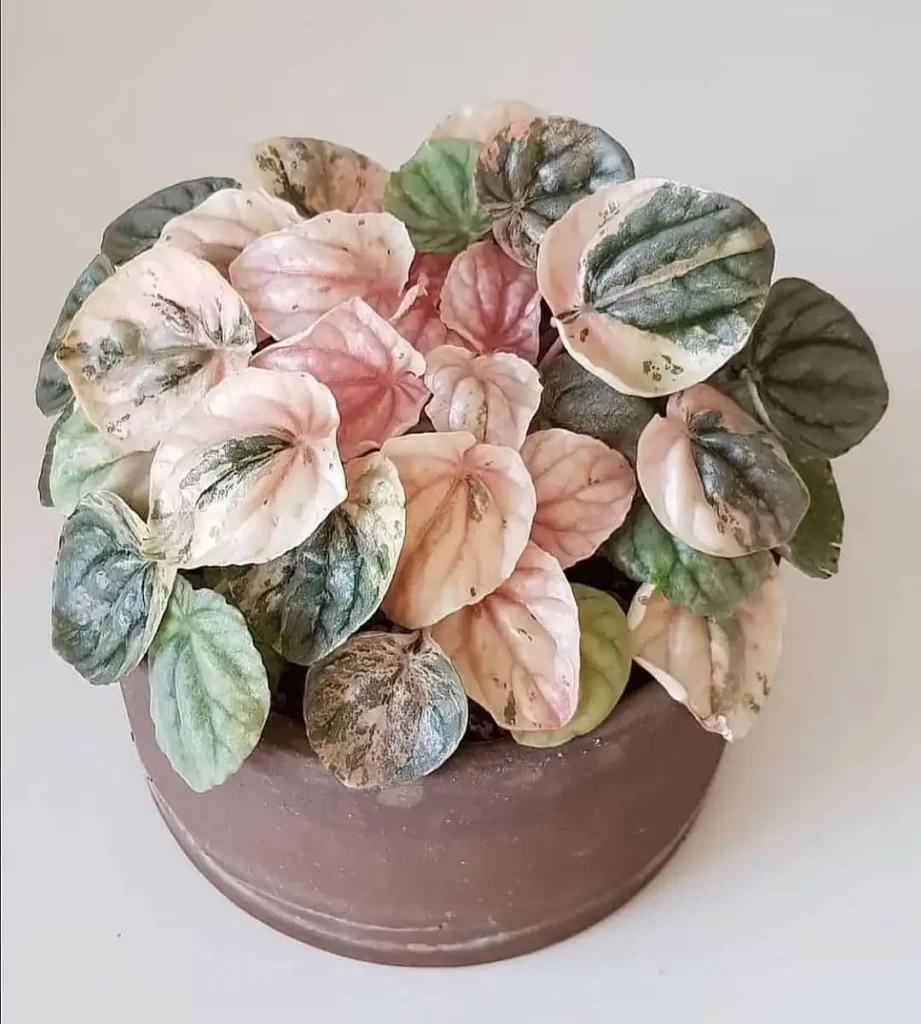
Peperomia caperata ‘Pink Lady’, commonly known as Pink Lady Peperomia, is a delightful and visually appealing cultivar originating from the tropical regions of South America. It is a member of the Peperomia genus, celebrated for its diverse and intriguing foliage.
The Pink Lady Peperomia is recognized for its striking, heart-shaped leaves that are typically a vibrant shade of pink or pinkish-red. The leaves have a distinctive wrinkled or crinkled texture, adding to their visual appeal. This particular cultivar is characterized by its enchanting leaf coloration and unique texture.
In terms of size, Peperomia caperata ‘Pink Lady’ remains relatively compact, typically reaching a height of about 6 to 8 inches (15 to 20 centimeters).
39. Prayer Pepper
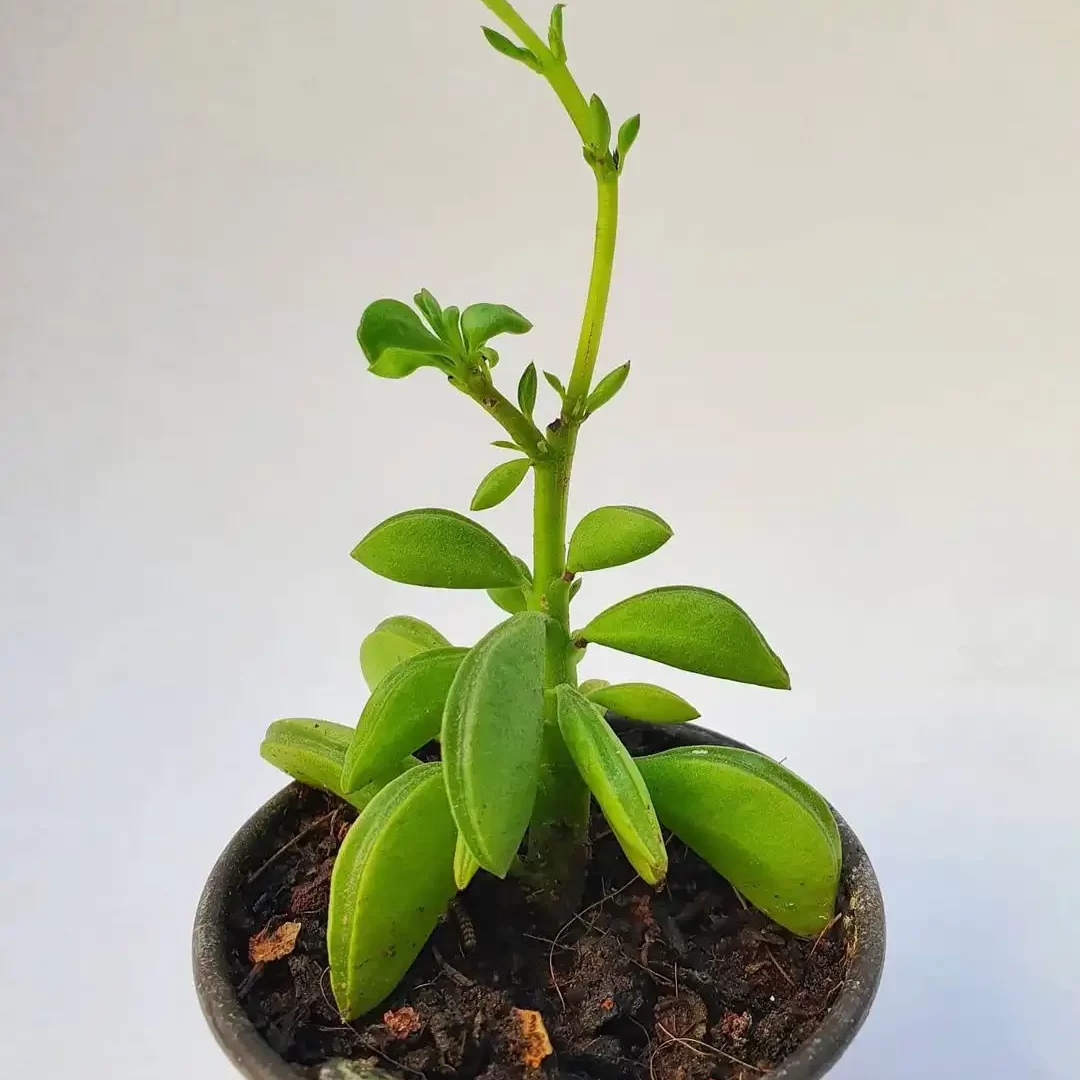
Peperomia dolabriformis, commonly known as Prayer Pepper, is a distinctive and visually appealing succulent originating from Mexico. It is a member of the Peperomia genus, which is known for its diverse and visually captivating foliage.
The Prayer Pepper is recognized for its unique leaf shape and arrangement. The leaves are thick, fleshy, and succulent, resembling little green beads or droplets. They grow in pairs, with one leaf overlapping the other, giving the appearance of clasped hands in prayer. This distinctive feature is what earned it the common name “Prayer Pepper.”
In terms of size, Peperomia dolabriformis remains relatively compact, typically reaching a height of about 4 to 8 inches (10 to 20 centimeters).
40. Privet
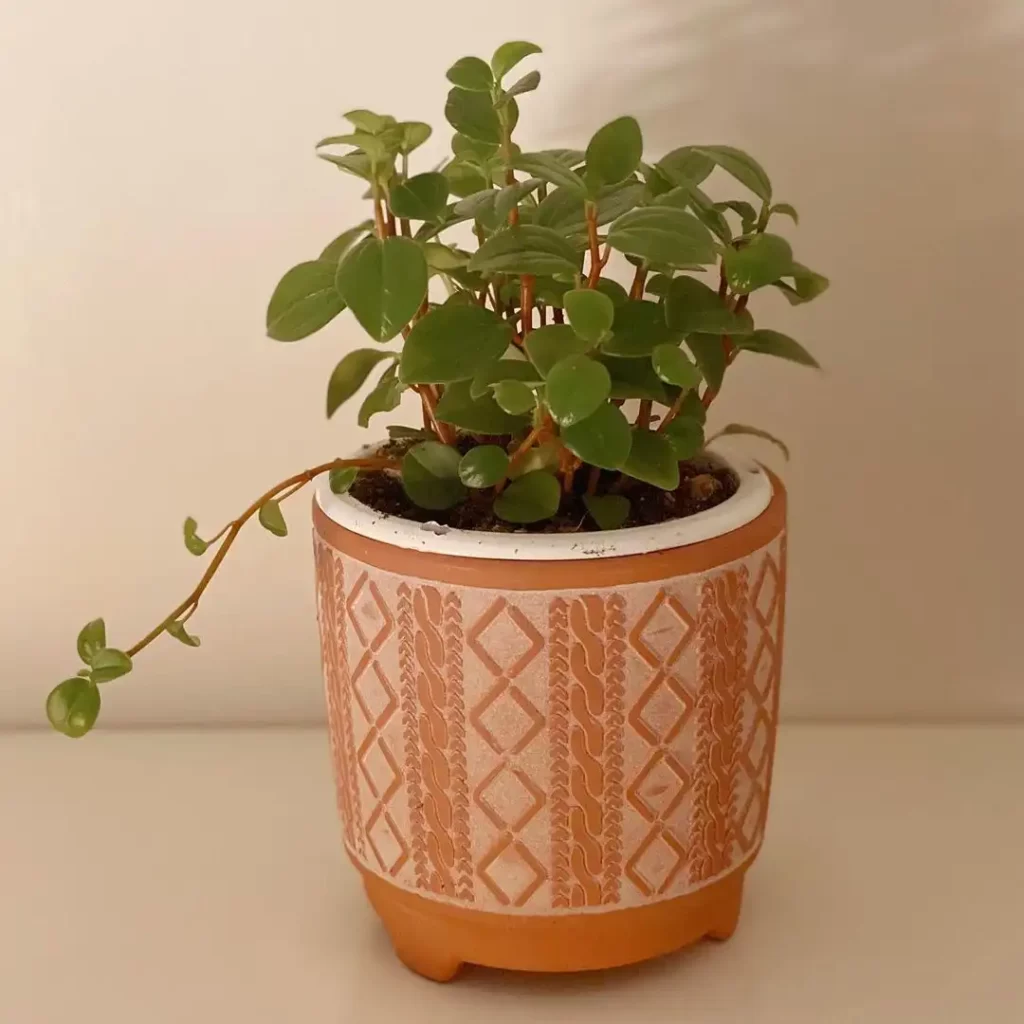
Peperomia glabella, also known as Peperomia Privet or Cypress Peperomia, is a fantastic choice for plant enthusiasts seeking an easy-to-care-for addition to their home or office.
This particular variety is native to various regions, including the Dominican Republic, Mexico, Puerto Rico, Panama, and parts of the Southern United States.
The Privet Peperomia is characterized by its vine-like growth habit, making it an excellent candidate for hanging baskets.
Its stems may display a reddish tint, adding to its visual appeal. The leaves of this plant are deep, dark green, providing a rich and vibrant backdrop.
41. Quito
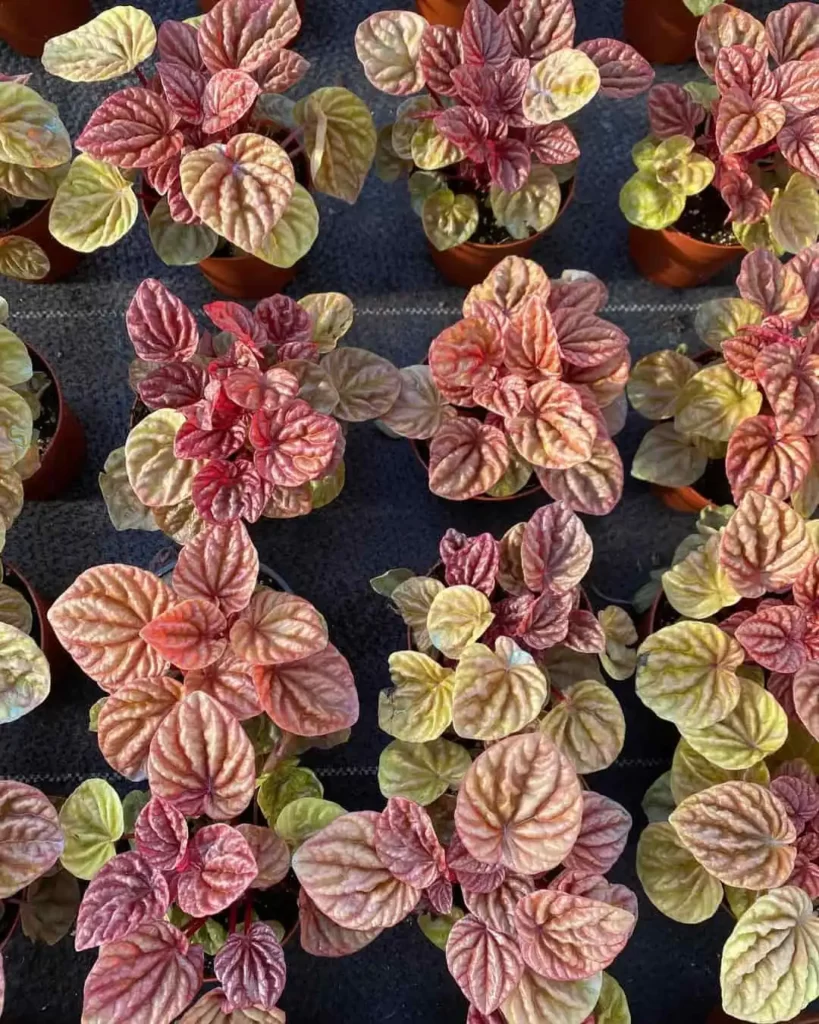
Peperomia caperata ‘Quito’ is a cultivar of the Peperomia caperata species, known for its unique and visually appealing foliage. It is a popular houseplant choice for its striking leaf patterns and compact growth habit.
‘Quito’ is recognized for its heart-shaped leaves that have a distinctive crinkled or corrugated texture. The leaves are typically a dark green color, and they may have a slightly reddish undertone. This cultivar is characterized by its charming leaf form and rich coloration.
In terms of size, Peperomia caperata ‘Quito’ remains relatively compact, typically reaching a height of about 6 to 8 inches (15 to 20 centimeters).
42. Rainbow
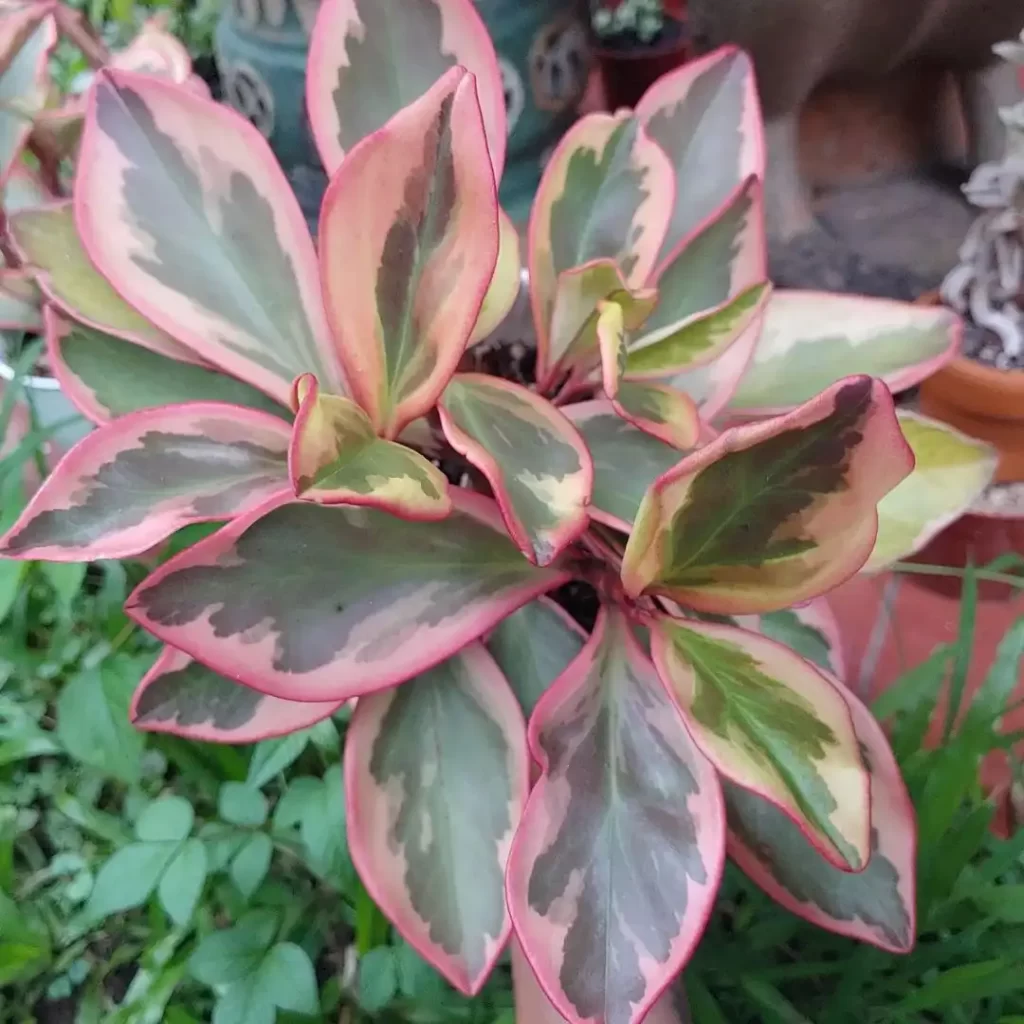
Peperomia clusiifolia ‘Rainbow’ is a cultivar of the Peperomia clusiifolia species, known for its vibrant and visually captivating foliage. It is a popular houseplant choice for its striking leaf patterns and compact growth habit.
The ‘Rainbow’ variety is recognized for its elliptical leaves that display a mesmerizing pattern of bright green, cream, and pinkish-red hues. Each leaf is a unique combination of these colors, creating a visually arresting effect. This cultivar is characterized by its enchanting leaf coloration and distinctive texture.
In terms of size, Peperomia clusiifolia ‘Rainbow’ remains relatively compact, typically reaching a height of about 6 to 8 inches (15 to 20 centimeters)
43. Raindrop
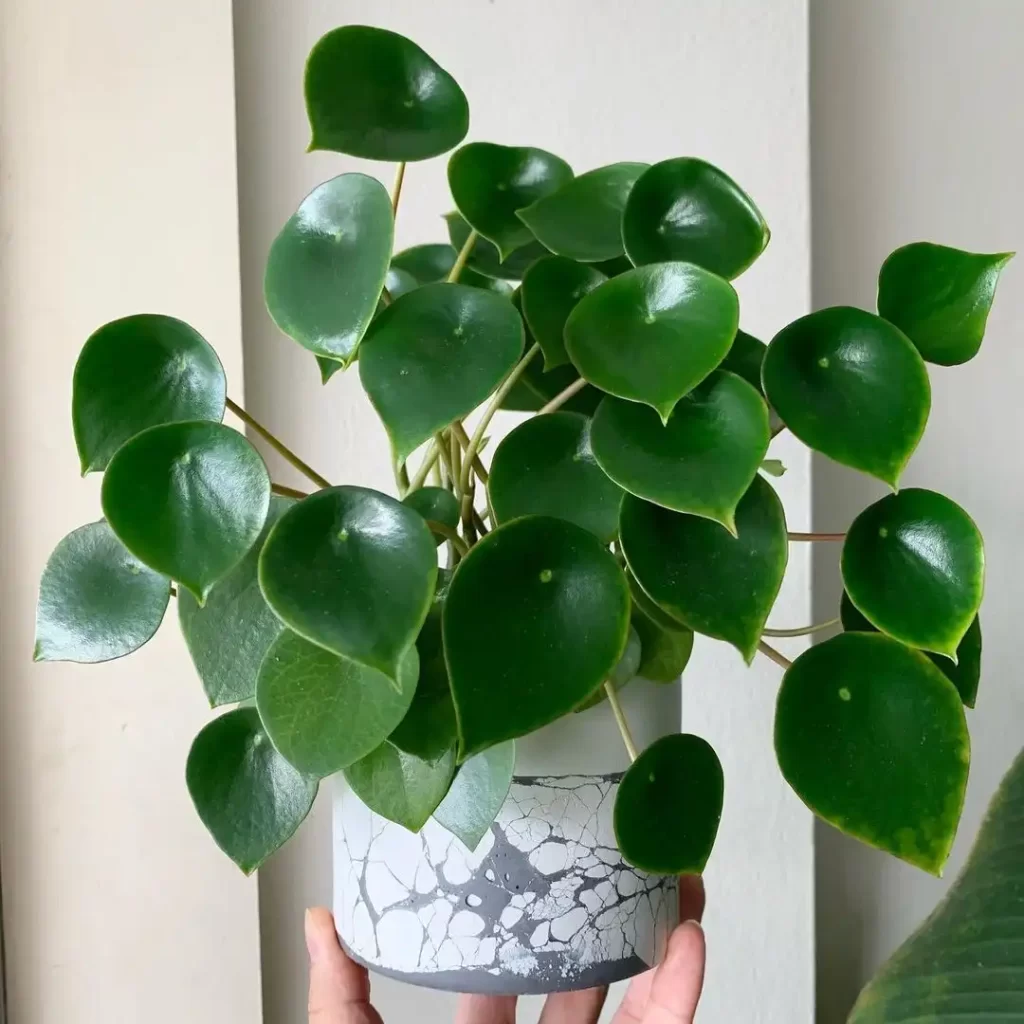
Peperomia polybotrya ‘Raindrop’, also known as Coin-Leaf Peperomia or Chinese Money Plant, is a popular and visually captivating houseplant. It is known for its distinctive, round, coin-like leaves, which give it a unique and charming appearance.
The ‘Raindrop’ variety is recognized for its succulent, glossy, and thick leaves. Each leaf is typically a rich, dark green color and has a slightly cupped or concave shape, resembling a coin. This cultivar is characterized by its delightful leaf form, which adds a touch of whimsy to any indoor space.
In terms of size, Peperomia polybotrya ‘Raindrop’ remains relatively compact, typically reaching a height of about 6 to 12 inches (15 to 30 centimeters).
44. Red-Edge
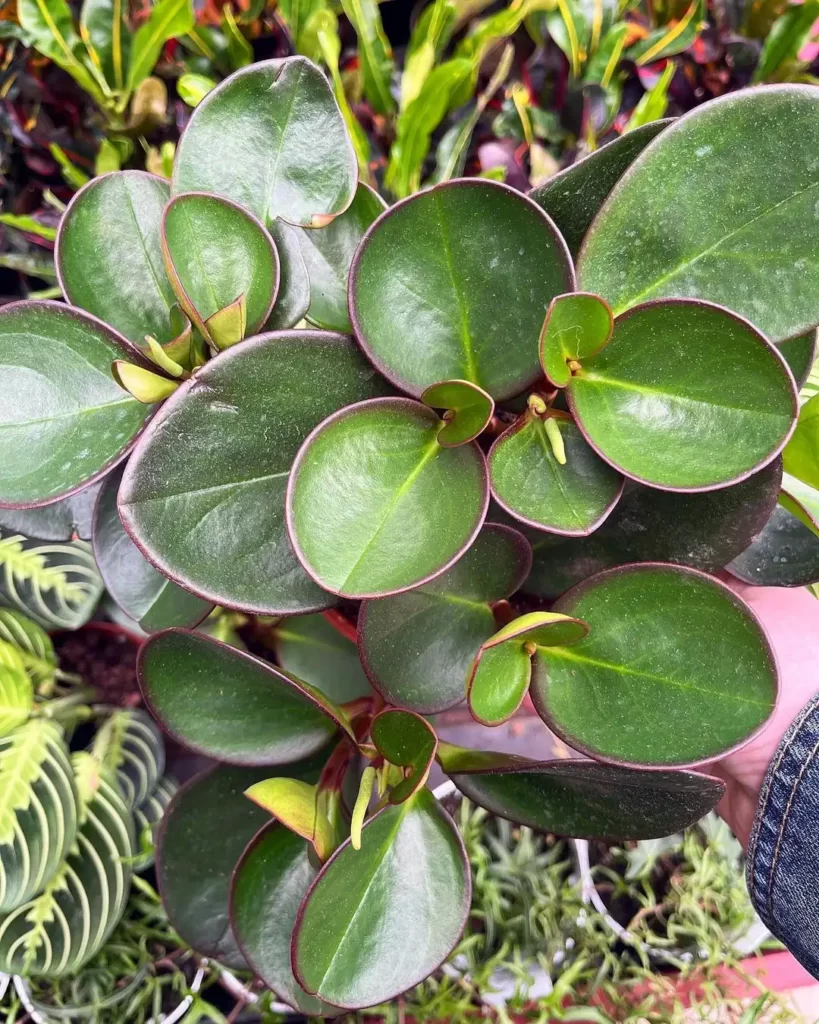
Peperomia clusiifolia ‘Red-Edge’ is a cultivar of the Peperomia clusiifolia species, known for its vibrant and visually captivating foliage. It is a popular houseplant choice for its striking leaf patterns and compact growth habit.
The ‘Red-Edge’ variety is recognized for its elliptical leaves that have a mesmerizing pattern of dark green with distinctive reddish edges. This striking contrast in coloration adds a dynamic and visually arresting effect to the plant. This cultivar is characterized by its enchanting leaf coloration and distinctive texture.
In terms of size, Peperomia clusiifolia ‘Red-Edge’ remains relatively compact, typically reaching a height of about 6 to 8 inches (15 to 20 centimeters).
45. Red Log
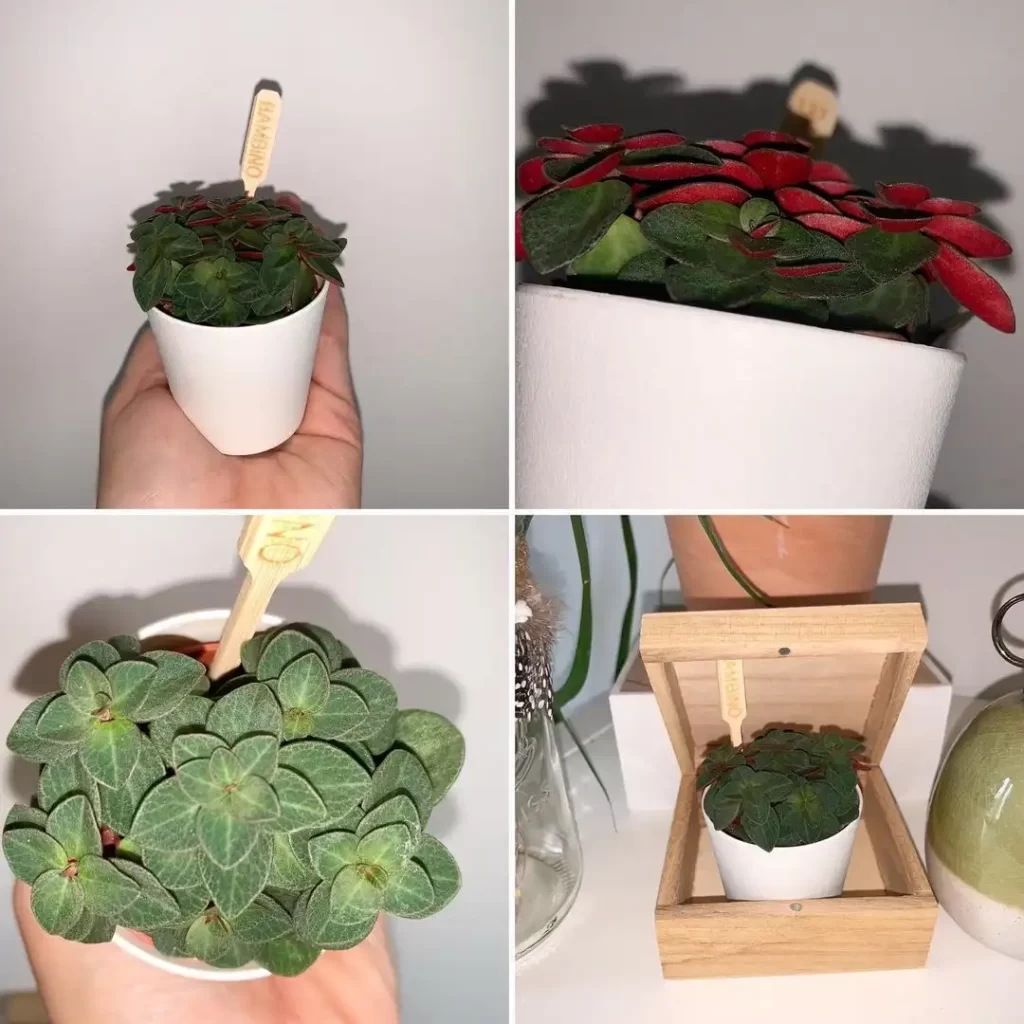
Peperomia verticillata ‘Red Log’ is a cultivar of the Peperomia verticillata species, known for its unique and visually captivating foliage. It is a popular houseplant choice for its striking leaf patterns and compact growth habit.
The ‘Red Log’ variety is recognized for its cylindrical, succulent-like leaves that are typically a vibrant shade of green with reddish-pink stems. This combination of colors adds a dynamic and visually arresting effect to the plant. This cultivar is characterized by its charming leaf form and rich coloration.
In terms of size, Peperomia verticillata ‘Red Log’ remains relatively compact, typically reaching a height of about 6 to 8 inches (15 to 20 centimeters).
46. Red and Silver
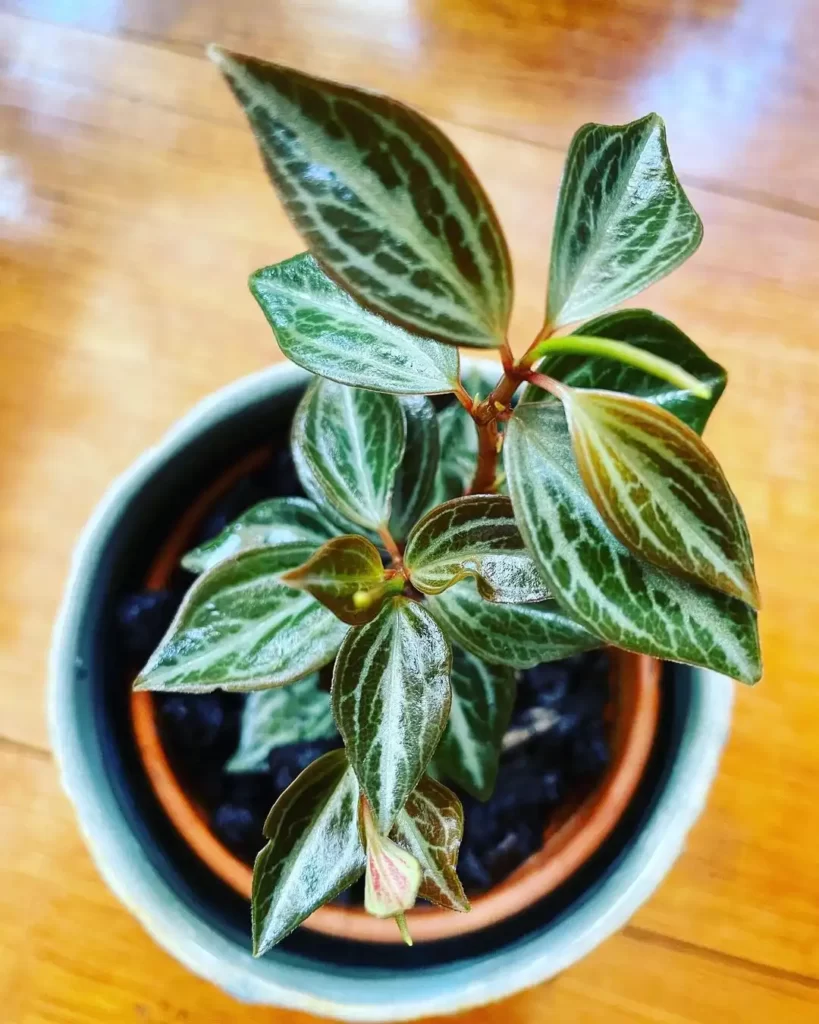
Peperomia trinervula ‘Red and Silver’ is a cultivar of the Peperomia trinervula species, known for its visually captivating foliage. It is a popular houseplant choice for its unique leaf patterns and compact growth habit.
The ‘Red and Silver’ variety is recognized for its oval-shaped leaves that have a mesmerizing pattern of silver veins contrasted against a deep green background. Additionally, the stems and leaf undersides may display a reddish tint, adding to the visual appeal. This cultivar is characterized by its enchanting leaf coloration and distinctive texture.
In terms of size, Peperomia trinervula ‘Red and Silver’ remains relatively compact, typically reaching a height of about 6 to 8 inches (15 to 20 centimeters).
47. Red Ripple
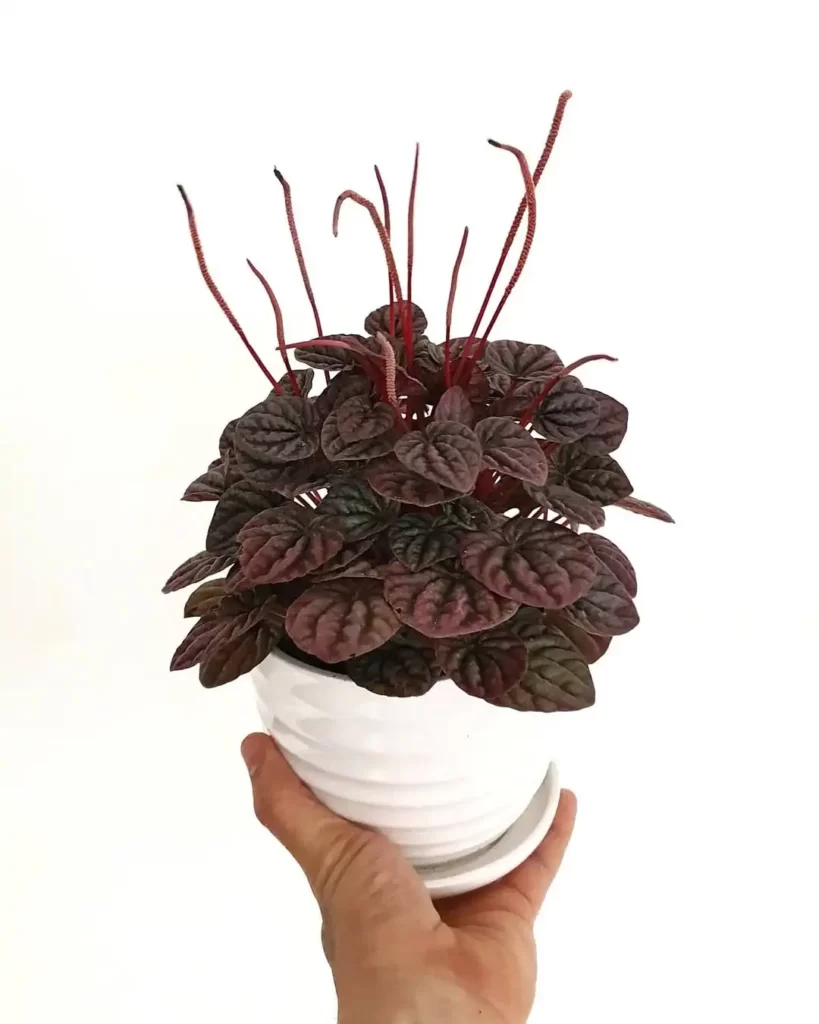
Peperomia caperata ‘Red Ripple’ is a cultivar of the Peperomia caperata species, known for its unique and visually captivating foliage. It is a popular houseplant choice for its striking leaf patterns and compact growth habit.
The ‘Red Ripple’ variety is recognized for its heart-shaped leaves that have a distinctive crinkled or corrugated texture. The leaves are typically a dark green color with reddish undersides, and they may have a slightly reddish tint along the edges, adding to their visual appeal. This cultivar is characterized by its delightful leaf form and rich coloration.
In terms of size, Peperomia caperata ‘Red Ripple’ remains relatively compact, typically reaching a height of about 6 to 8 inches (15 to 20 centimeters).
48. Rubella
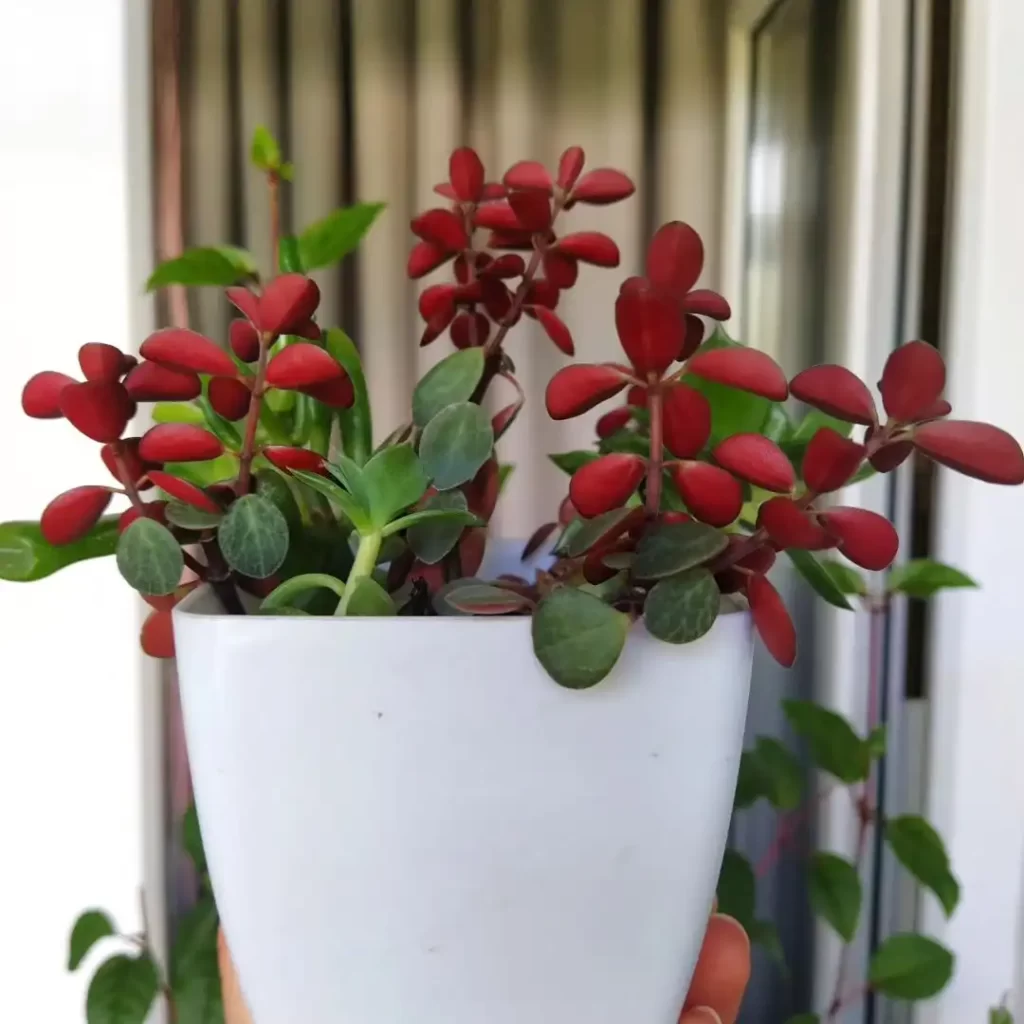
Peperomia rubella is a charming and distinctive houseplant known for its visually captivating foliage. This species is a member of the Peperomia genus, celebrated for its diverse and intriguing leaf patterns.
Peperomia rubella is recognized for its unique, lance-shaped leaves that are typically dark green with striking red undersides. This combination of colors adds to the visual appeal of the plant. The leaves are small, thick, and slightly succulent in texture, which is a common trait in many Peperomia species.
In terms of size, Peperomia rubella typically remains relatively compact, making it an excellent choice for small spaces, desks, or shelves. It usually reaches a height of about 6 to 8 inches (15 to 20 centimeters).
49. Ruby Cascade
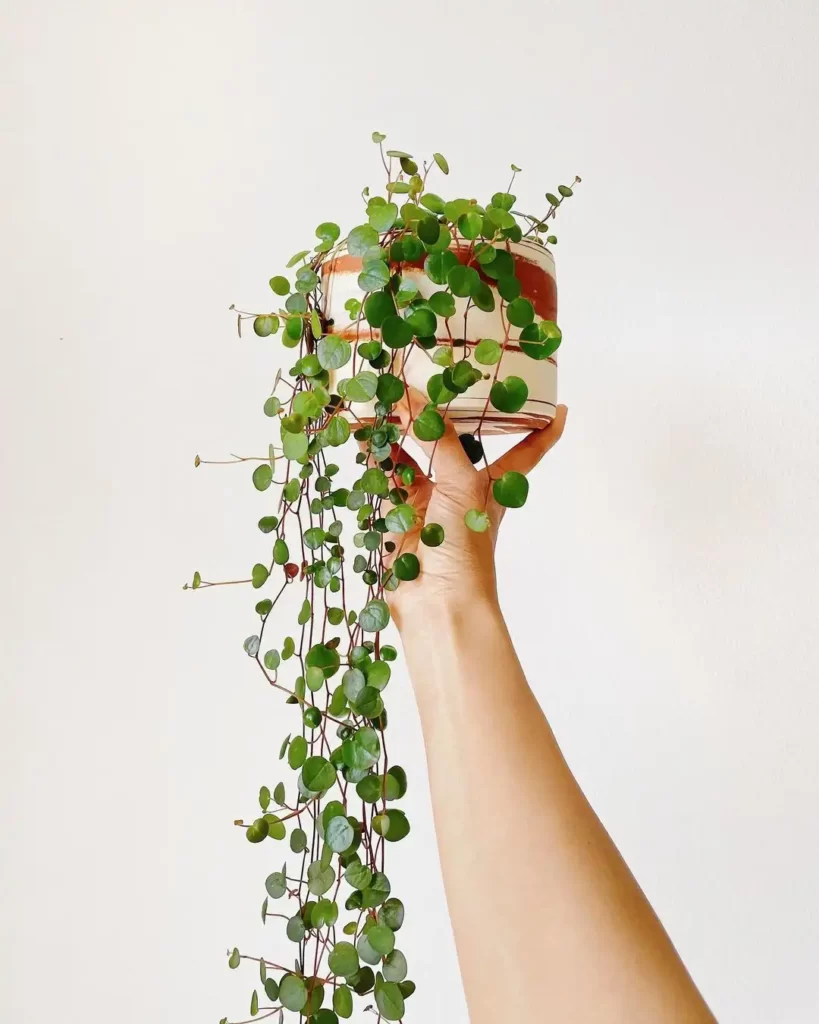
Peperomia Ruby Cascade is a cultivar of the Peperomia genus known for its distinctive cascading growth habit and visually captivating foliage. It’s a popular choice among houseplant enthusiasts for its unique appearance.
The Ruby Cascade variety is recognized for its trailing stems that are covered in small, succulent-like leaves. The leaves are typically a rich, dark green color with hints of red or burgundy, especially on the undersides. This combination of colors gives the plant a striking and eye-catching appearance. Its cascading growth habit makes it well-suited for hanging baskets or elevated planters.
In terms of size, Peperomia Ruby Cascade can grow to a length of around 12 to 18 inches (30 to 45 centimeters), depending on its environment and care.
50. Ruby Glow
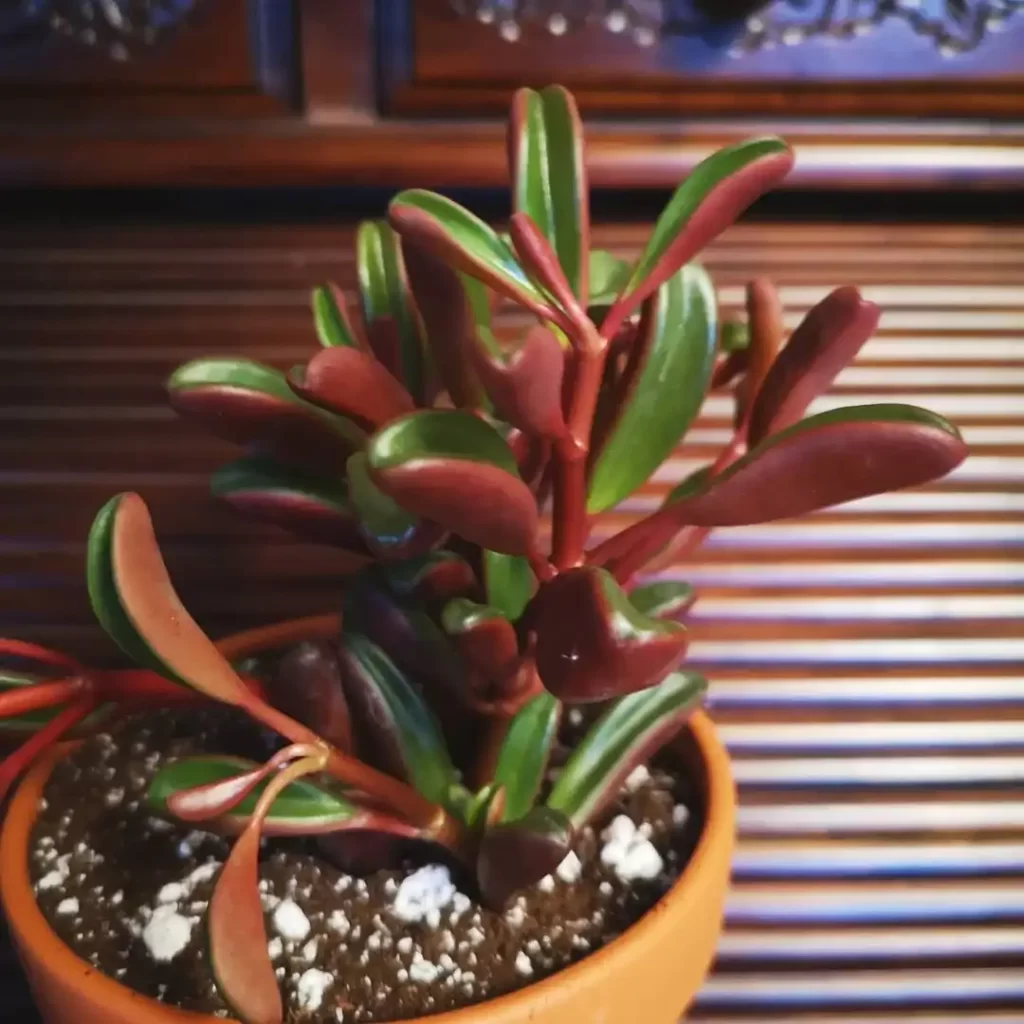
Peperomia graveolens ‘Ruby Glow’ is a striking succulent houseplant known for its visually captivating foliage. It’s a cultivar of the Peperomia graveolens species and is popular among plant enthusiasts for its unique appearance.
The ‘Ruby Glow’ variety is recognized for its thick, upright stems and fleshy, pointed leaves. The leaves are typically a deep green color, with a translucent, ruby-red edge. This combination of colors gives the plant its distinctive and eye-catching look. The succulent nature of the leaves makes it well-adapted to drier conditions.
In terms of size, Peperomia graveolens ‘Ruby Glow’ typically reaches a height of about 6 to 8 inches (15 to 20 centimeters).
51. Silver Leaf
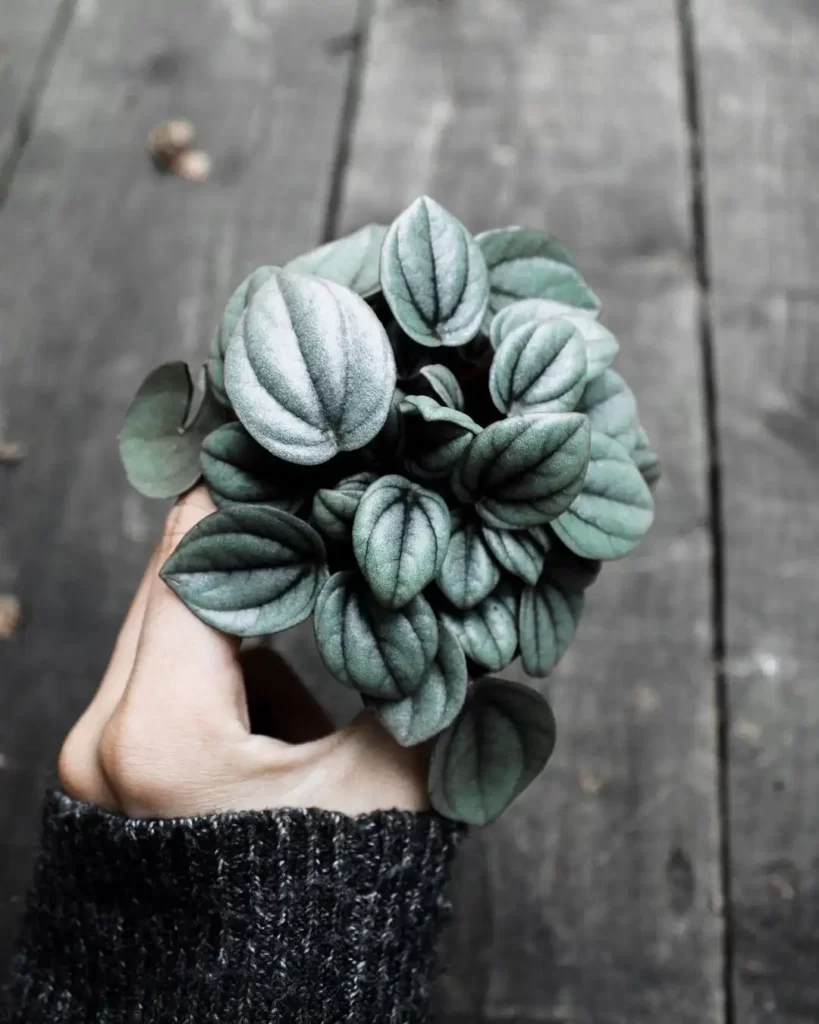
Peperomia griseoargentea ‘Silver Leaf’ is a cultivar of the Peperomia griseoargentea species, known for its visually captivating foliage. It is a popular houseplant choice for its striking leaf patterns and compact growth habit.
The ‘Silver Leaf’ variety is recognized for its elliptical leaves that have a mesmerizing pattern of silver-gray variegation on a dark green background. This contrast in colors adds to the visual appeal of the plant. This cultivar is characterized by its enchanting leaf coloration and distinctive texture.
In terms of size, Peperomia griseoargentea ‘Silver Leaf’ remains relatively compact, typically reaching a height of about 6 to 8 inches (15 to 20 centimeters).
52. String of Turtles
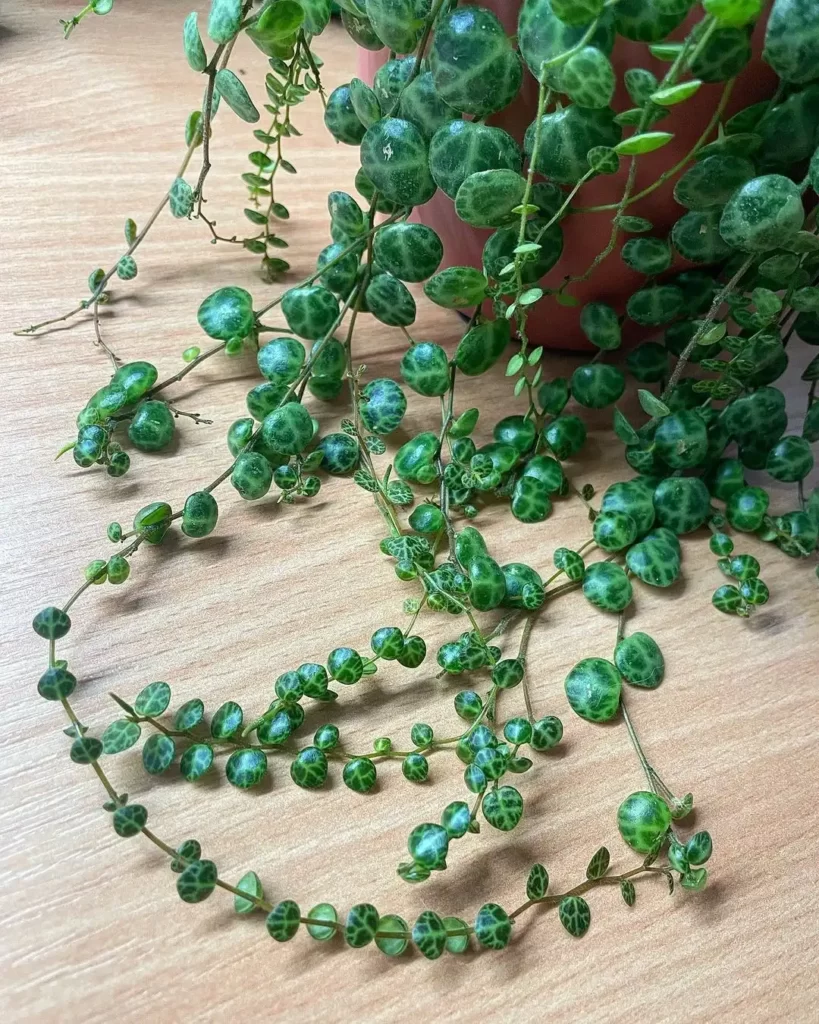
Peperomia prostrata, commonly known as String of Turtles, is a charming trailing succulent that is native to Brazil. It is a member of the Peperomia genus, which includes many small, succulent-like plants known for their unique foliage.
String of Turtles gets its name from its distinctive leaves, which are small, round, and have a pattern that resembles the markings on a turtle’s shell. The leaves are typically dark green with silvery-white markings. The plant produces long, trailing stems, making it an excellent choice for hanging baskets or elevated planters.
In terms of size, String of Turtles can grow up to 3 feet long. However, it is more likely to grow to a length of 1-2 feet in most indoor settings.
53. Sweetheart
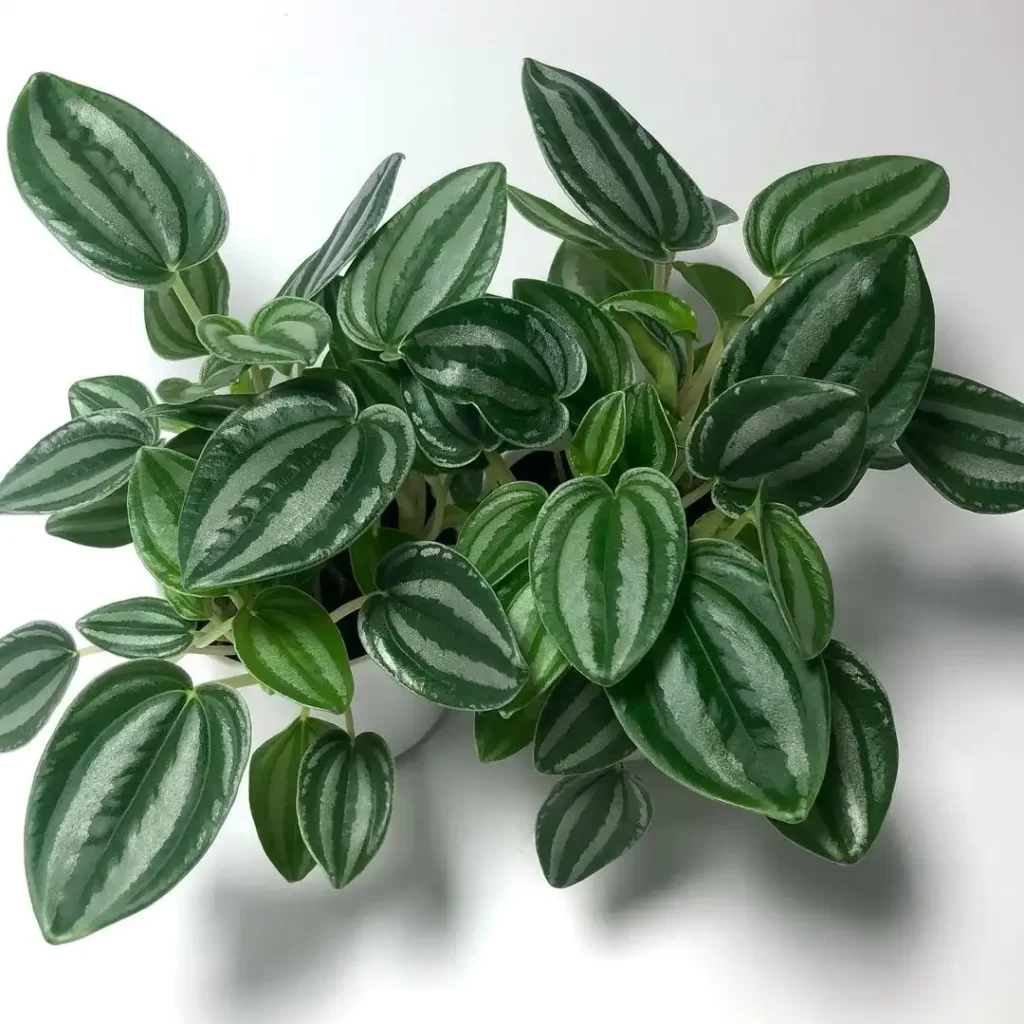
Peperomia Sweetheart, scientifically known as Peperomia scandens var. argyreia, is a charming trailing plant that belongs to the Piperaceae family. It is also commonly known as the “Cupid Peperomia” due to its heart-shaped leaves.
This particular Peperomia variety is recognized for its adorable heart-shaped leaves, which are typically light green with silver-grayish stripes, resembling the patterns found on watermelon rinds. The leaves grow on trailing stems, making it an ideal choice for hanging planters or elevated containers.
In terms of size, Peperomia Sweetheart is a small, compact plant that typically grows to a height of 6-8 inches and a width of 6-10 inches. It is a slow-growing plant and rarely grows taller than 1 foot.
54. Taco Leaf
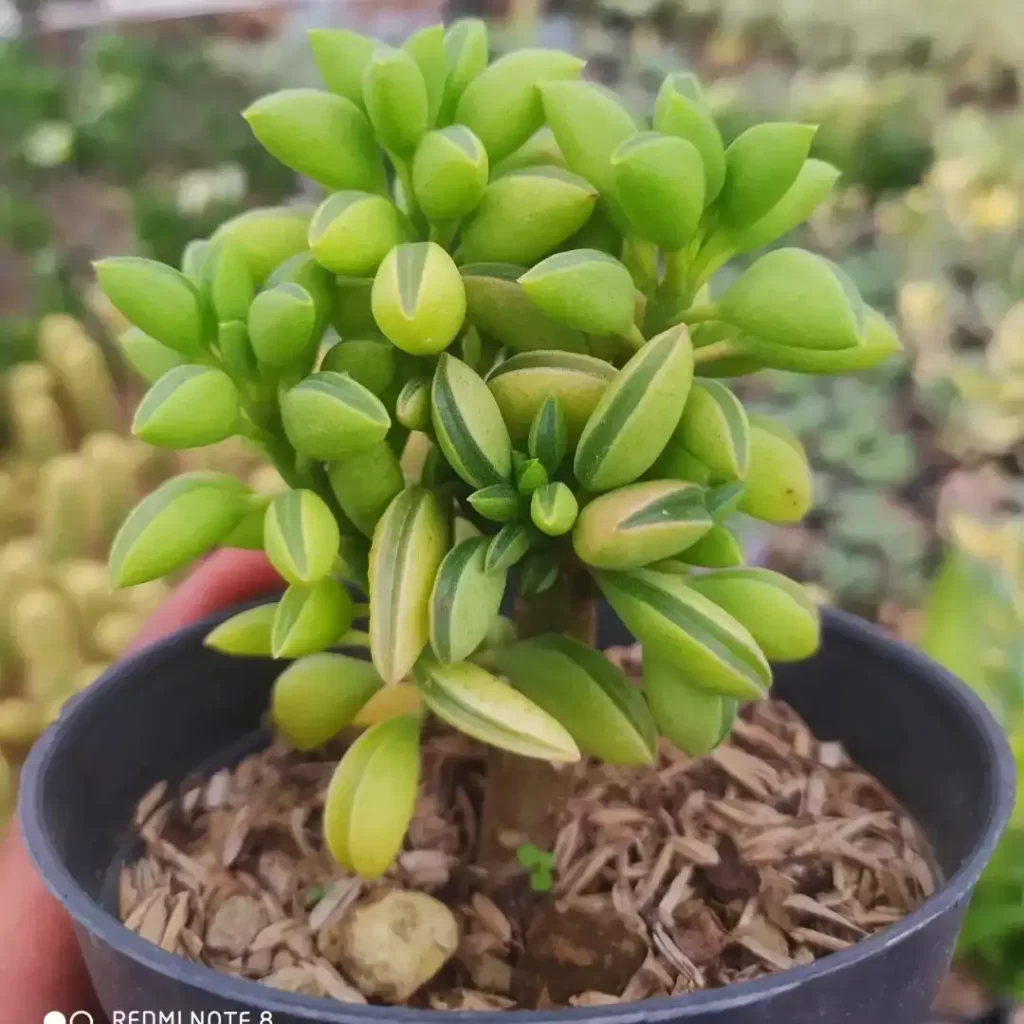
Peperomia nivalis ‘Taco Leaf’ is a unique cultivar of the Peperomia nivalis species, known for its visually captivating foliage. It is a popular choice among plant enthusiasts for its distinctive appearance.
The ‘Taco Leaf’ variety is recognized for its succulent-like leaves that have a distinctive concave or “taco” shape. The leaves are typically a rich, dark green color and have a slightly glossy texture. This cultivar is characterized by its charming leaf form and rich coloration.
In terms of size, Peperomia nivalis ‘Taco Leaf’ typically reaches a height of about 6 to 8 inches (15 to 20 centimeters).
55. Trailing Jade
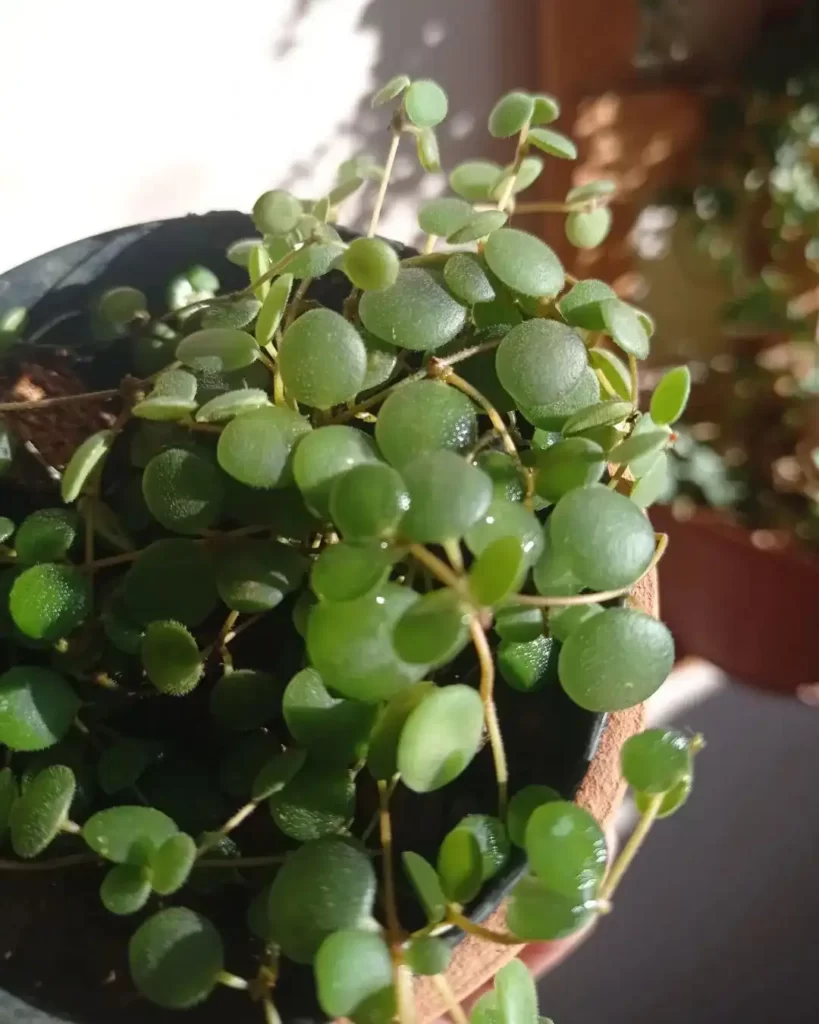
Peperomia rotundifolia ‘Trailing Jade’ is a popular cultivar known for its trailing growth habit and charming, succulent-like foliage. It’s a member of the Peperomia genus, which includes many small, succulent-like plants known for their unique leaf shapes.
The ‘Trailing Jade’ variety is recognized for its small, rounded leaves that are typically a bright, glossy green. The stems of this Peperomia grow in a cascading or trailing manner, making it an excellent choice for hanging baskets or elevated planters.
In terms of size, Peperomia rotundifolia ‘Trailing Jade’ can grow up to 3 feet long. However, it is more likely to grow to a length of 1-2 feet in most indoor settings.
56. Turboensis
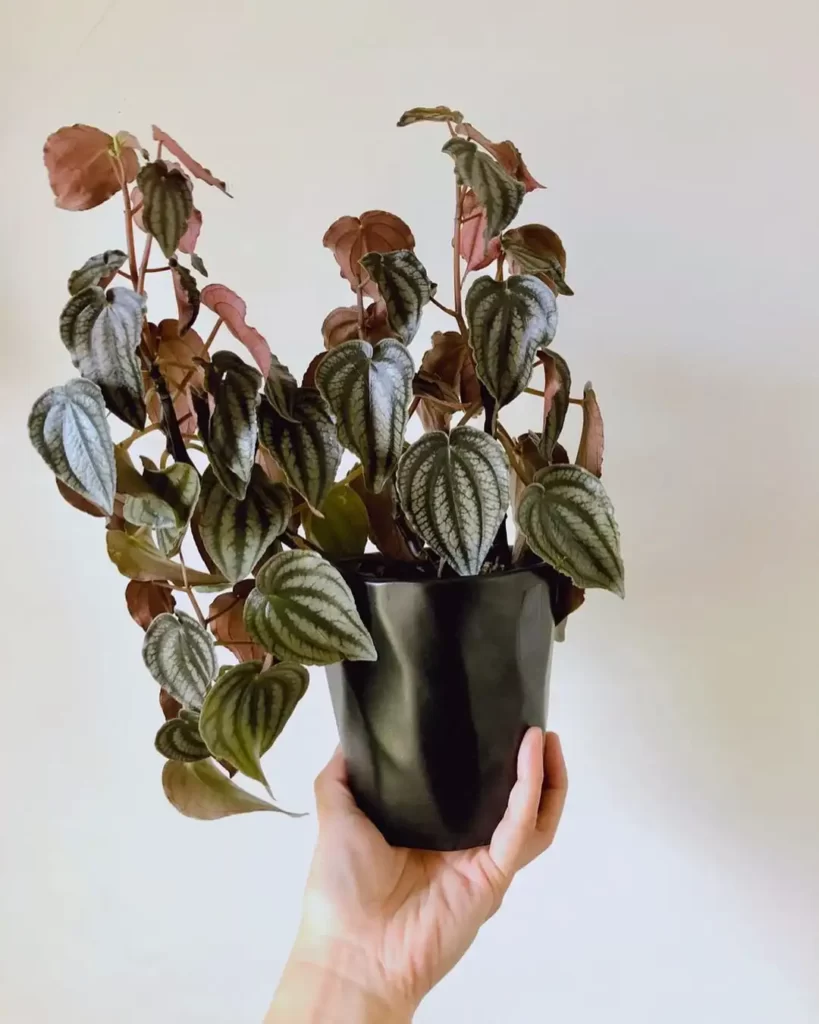
Peperomia turboensis, also known as Turbo Pepperface, is a charming succulent plant that belongs to the Peperomia genus. It is native to Colombia and is known for its unique and visually appealing foliage.
The leaves of Peperomia turboensis are oval-shaped and succulent-like, with a deep green color and a slightly textured surface.
They grow in an upright manner and are often marked with attractive patterns or variegations. This particular species can grow to a height of 2-3 feet (60-90 centimeters) and a width of 1-2 feet (30-60 centimeters).
57. Urvilleana
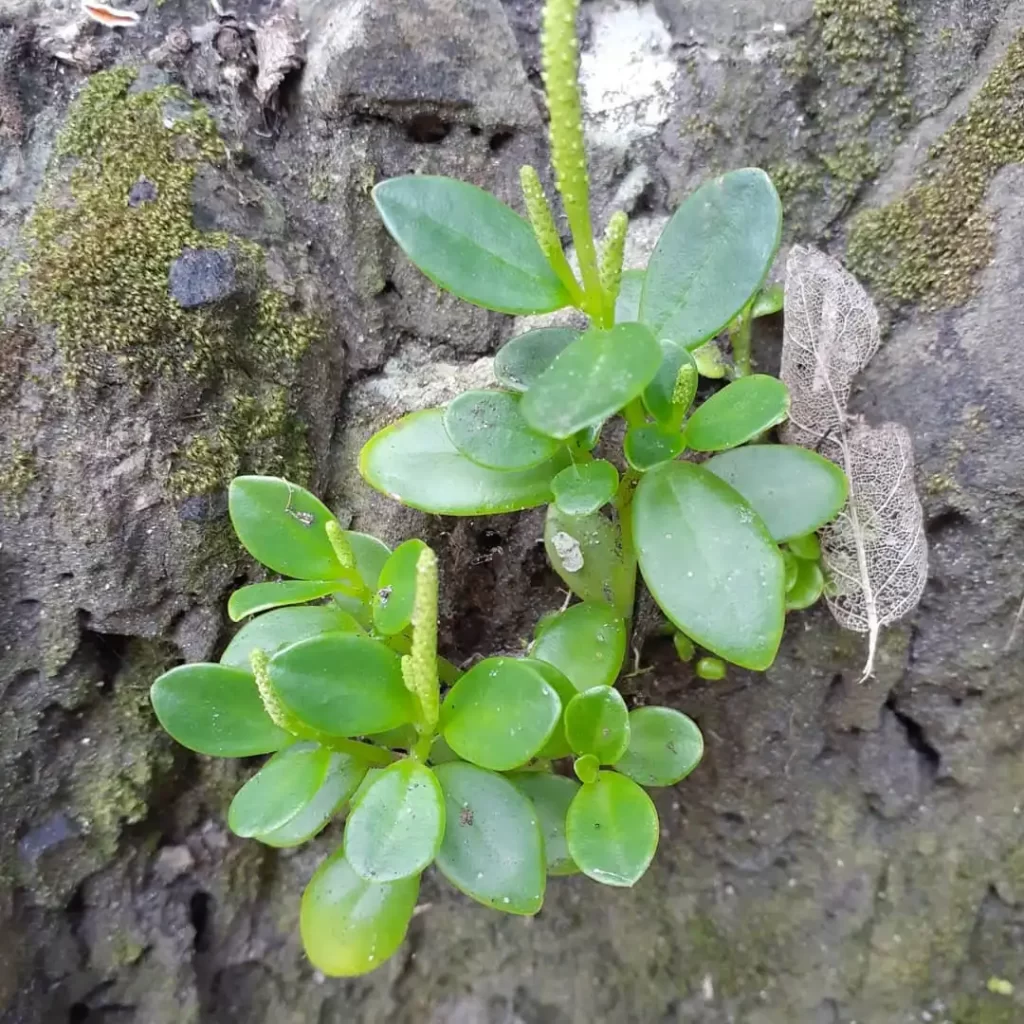
Peperomia urvilleana, commonly known as Urvilleana Peperomia, is a charming succulent plant that belongs to the Peperomia genus. It is native to Venezuela and is known for its unique and visually appealing foliage.
The leaves of Peperomia urvilleana are fleshy, heart-shaped, and have a glossy texture. They are typically a vibrant green color and may have distinctive white or cream-colored veining.
The leaves grow in a rosette pattern, creating a visually striking effect. This particular species is relatively compact and typically reaches a height of about 6 to 8 inches (15 to 20 centimeters).
58. Vestita var. Lindenii
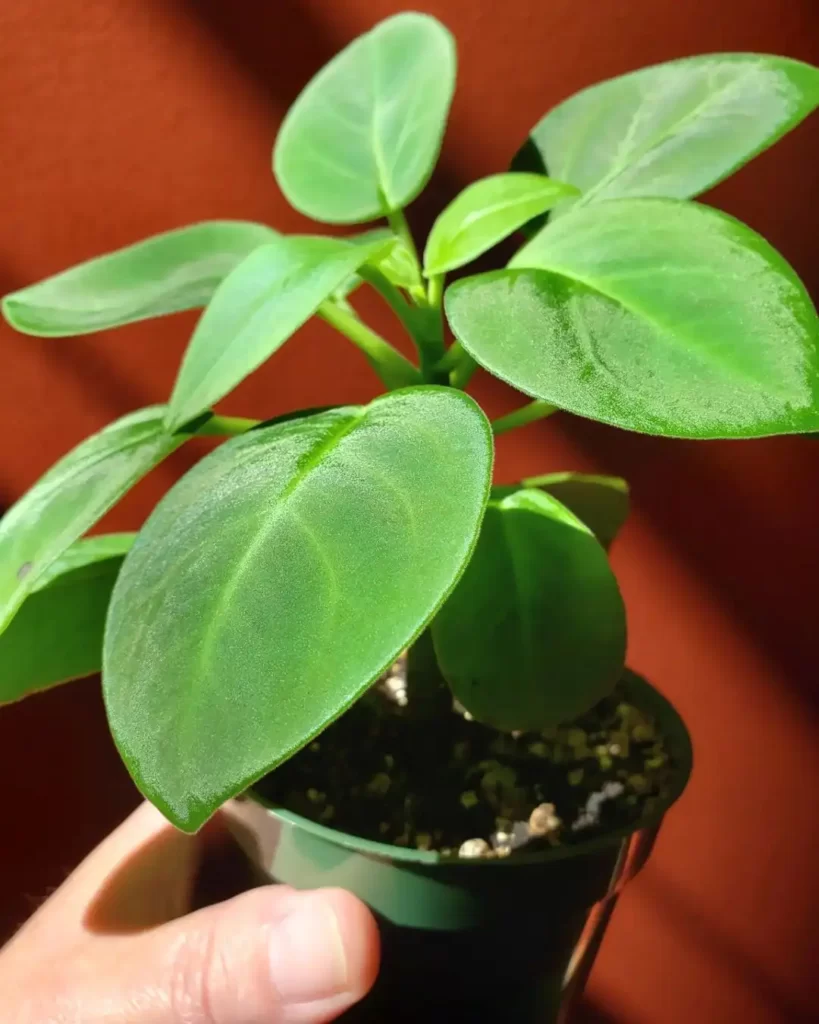
Peperomia Vestita var. Lindenii is a captivating variety of the Peperomia family known for its unique features.
Scientifically referred to by the same name as Peperomia Vestita var. Lindenii, this perennial gem originates from tropical regions, adding a touch of elegance to indoor spaces.
With its compact growth habit, the Peperomia Vestita var. Lindenii reaches heights of up to 12 inches. Its leaves are a standout feature, showcasing a mix of deep green shades and intricate patterns, enhancing the plant’s visual appeal.
Thriving in medium to bright, indirect light, this peperomia variety is relatively easy to care for. Watering should be done when the top layer of soil becomes dry, avoiding over-watering.
The Peperomia Vestita var. Lindenii’s unique appearance and manageable size make it a sought-after choice for plant enthusiasts, enhancing interiors with its captivating presence and natural allure.
59. Vining
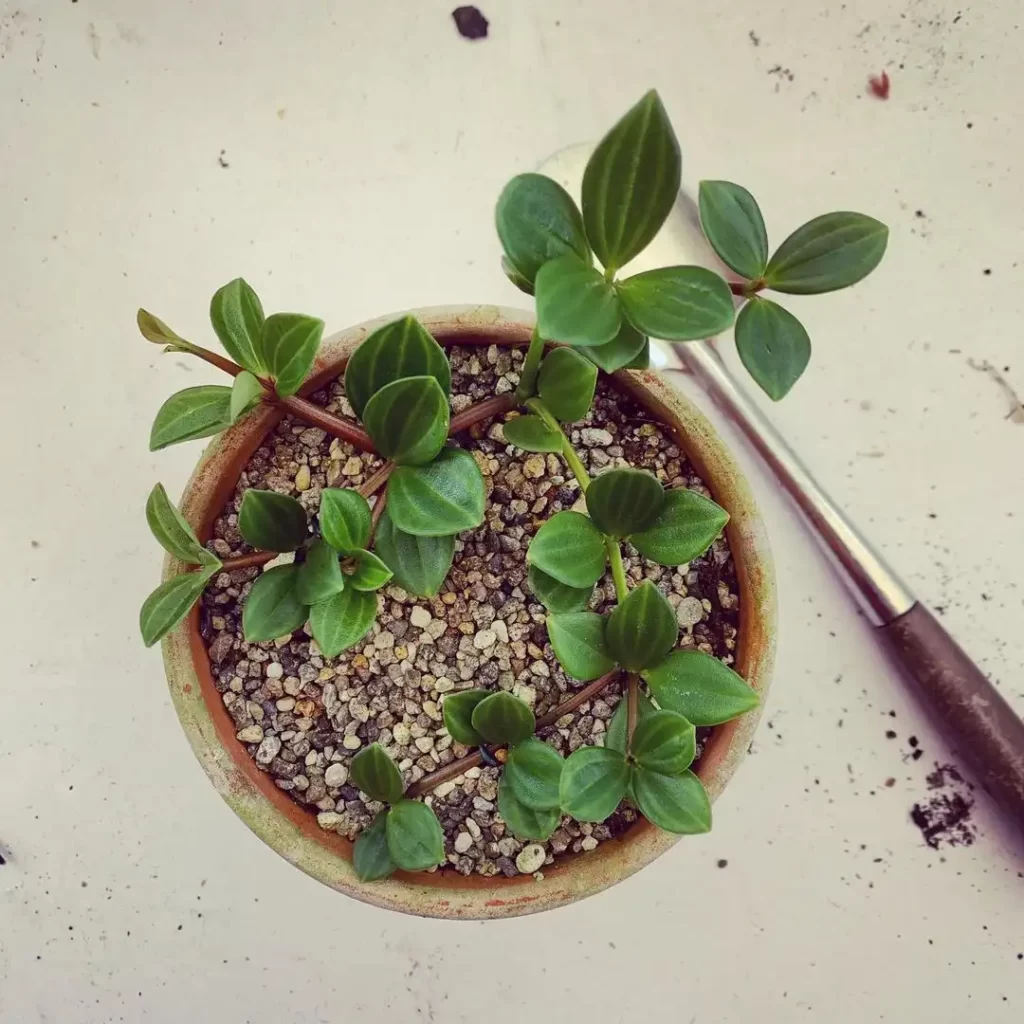
Peperomia dahlstedtii ‘Vining’ is a unique variety of Peperomia known for its trailing growth habit. It’s a cultivar of the Peperomia dahlstedtii species, which is a member of the Peperomia genus. This particular variety is popular among plant enthusiasts for its distinctive appearance.
The ‘Vining’ variety is recognized for its slender, vining stems that can grow to several feet in length. The leaves are small, succulent-like, and typically have a dark green color. They are arranged alternately along the stems, creating a cascading effect. This growth habit makes it well-suited for hanging baskets or elevated planters.
The ‘Vining’ variety can grow up to several feet in length, but it is more likely to grow to a length of 1-2 feet in most indoor settings.
60. Viridis Variegata
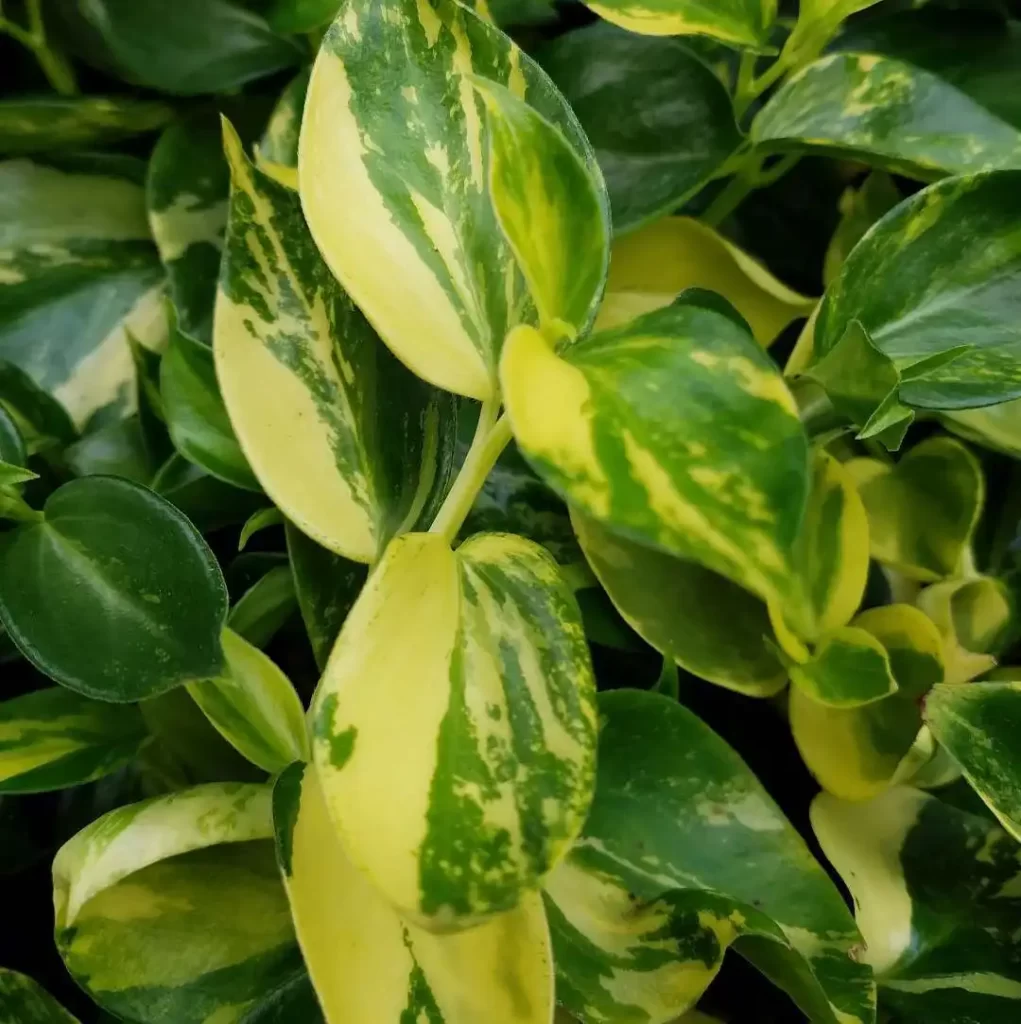
Peperomia viridis var. variegata, commonly known as Variegated Radiator Plant, is a delightful houseplant known for its visually captivating foliage. It is a cultivar of the Peperomia viridis species, which is a member of the Peperomia genus.
This particular Peperomia variety is recognized for its distinctive variegated leaves. Each leaf displays a mesmerizing pattern of light and dark green hues, creating a visually arresting effect. The leaves are generally small, thick, and have a slightly succulent texture, which is a common trait in many Peperomia species.
The plant typically grows in a compact manner, reaching a height of around 8 to 12 inches (20 to 30 centimeters).
How to Care for Any Peperomia Plants for Indoor Garden?
Caring for Peperomia plants in an indoor garden can be a rewarding and relatively straightforward endeavor.
While specific care requirements may vary slightly among different Peperomia species, there are common guidelines that apply to most varieties. Here’s a comprehensive guide on how to care for your Peperomia plants:
Light:
Peperomias thrive in medium to bright, indirect light. Avoid exposing them to direct sunlight, which can scorch their leaves. Place them near a window with filtered light or provide artificial lighting if needed.
Watering:
Allow the top layer of soil to dry between waterings. Over-watering can lead to root rot, so it’s crucial to avoid keeping the soil constantly moist. Water less frequently during the winter months when the plant’s growth slows down.
Soil:
Use a well-draining soil mix with good aeration. A mix formulated for succulents or cacti works well for most Peperomias. Proper drainage prevents waterlogged roots and ensures healthy growth.
Humidity:
Peperomias prefer moderate humidity levels. If your indoor environment is dry, consider using a humidifier, placing a tray of water near the plant, or misting the leaves occasionally to increase humidity.
Temperature:
Keep your Peperomias in a temperature range of 65-75°F (18-24°C). Avoid exposing them to sudden temperature fluctuations or drafts.
Fertilizing:
Feed your Peperomias with a balanced liquid fertilizer diluted to half strength during the growing season (spring and summer) every 4-6 weeks. Reduce or stop fertilizing during the dormant period (fall and winter).
Pruning:
Prune any leggy or yellowing growth to encourage bushier growth. Regularly pinch off faded flowers and trim back long stems to maintain a neat appearance.
Repotting:
Repot your Peperomias every 2-3 years, typically in the spring. Choose a slightly larger pot and fresh potting mix. Repotting not only provides room for growth but also refreshes the soil.
Pest Management:
Keep an eye out for common pests such as spider mites, mealybugs, and aphids. Regularly inspect your plants and treat infestations promptly with natural remedies or insecticidal soap.
Propagation:
Peperomias can be propagated through leaf or stem cuttings. Place cuttings in a well-draining potting mix and provide the appropriate conditions for them to root and establish.
Remember that while these guidelines cover the general care of Peperomia plants, individual species may have specific preferences or requirements. Observing your plants closely and adjusting care as needed will help ensure their health and vitality in your indoor garden.
Conclusion
The world of Peperomia varieties is a diverse and captivating one, offering a plethora of options to choose from for your indoor garden.
Each variety has its own unique features, growth habits, and care requirements, making them a wonderful addition to any home or office.
Whether you’re drawn to the heart-shaped leaves, the intricate patterns, or the trailing growth, there’s a Peperomia variety that’s sure to steal your heart and bring joy to your space.
With their relatively easy care and wide array of appearances, Peperomias are the perfect choice for both beginner and experienced plant enthusiasts alike.
So, whether you’re looking for a compact tabletop plant or a cascading beauty for your shelves, there’s a Peperomia variety waiting to thrive in your indoor garden.
